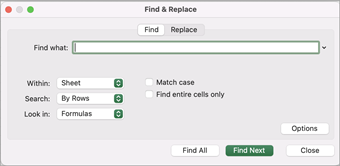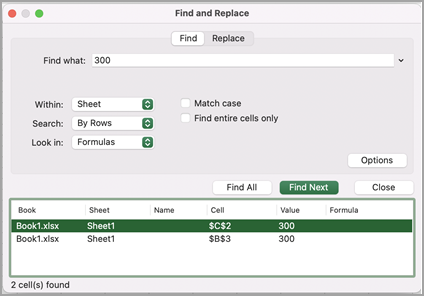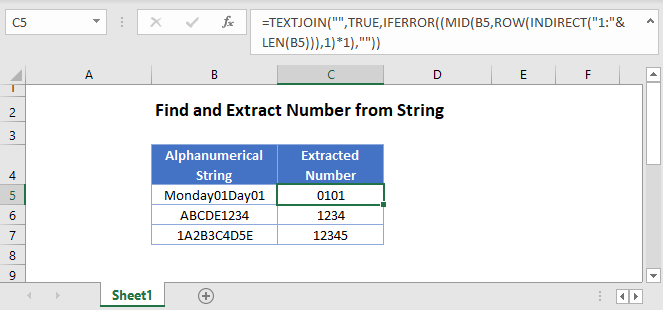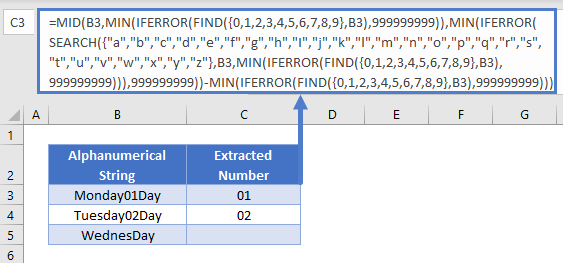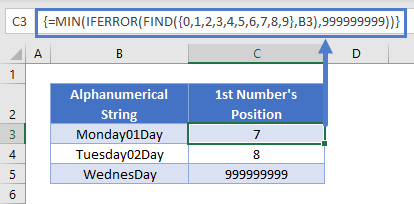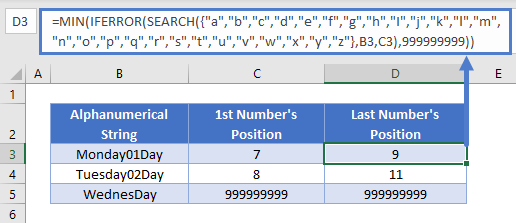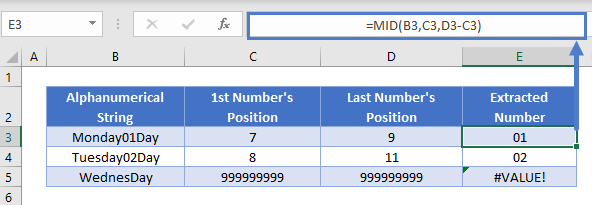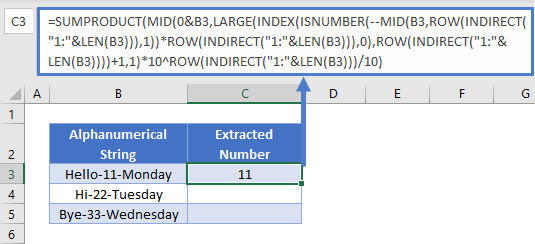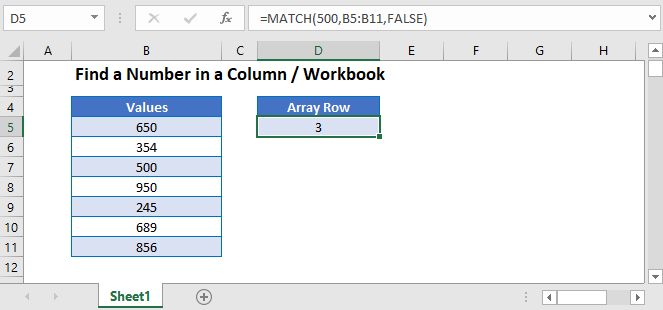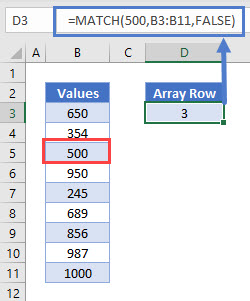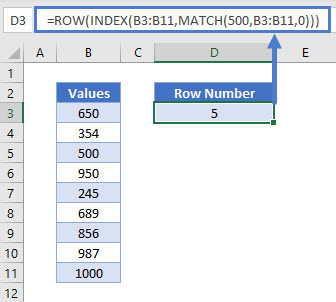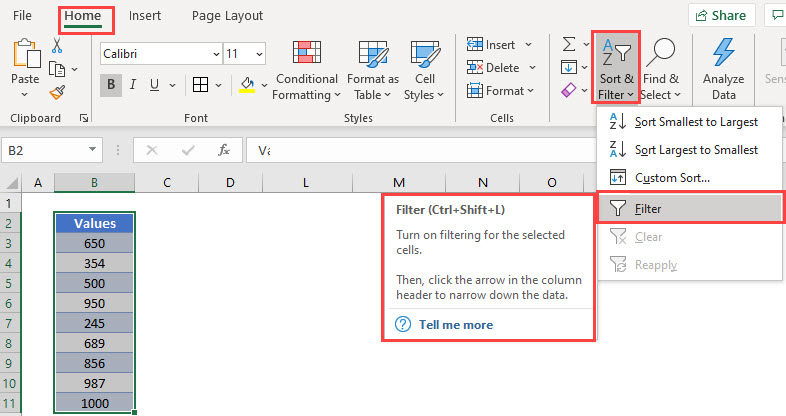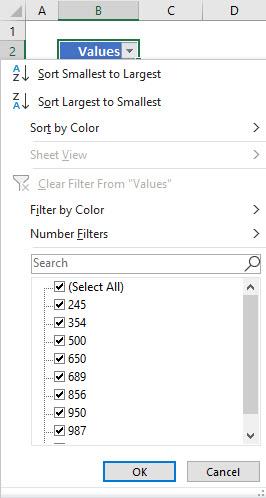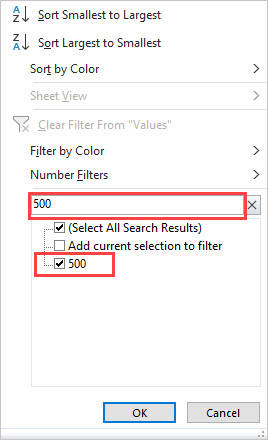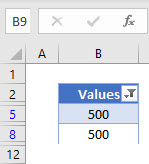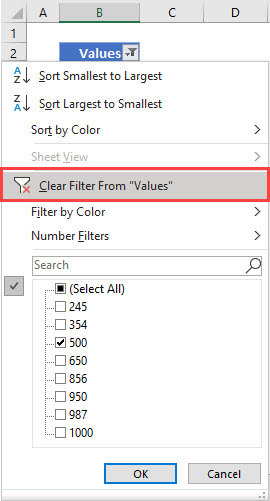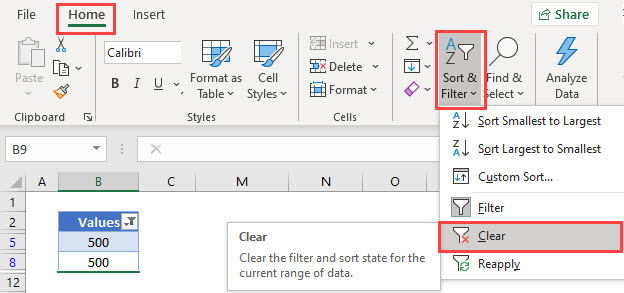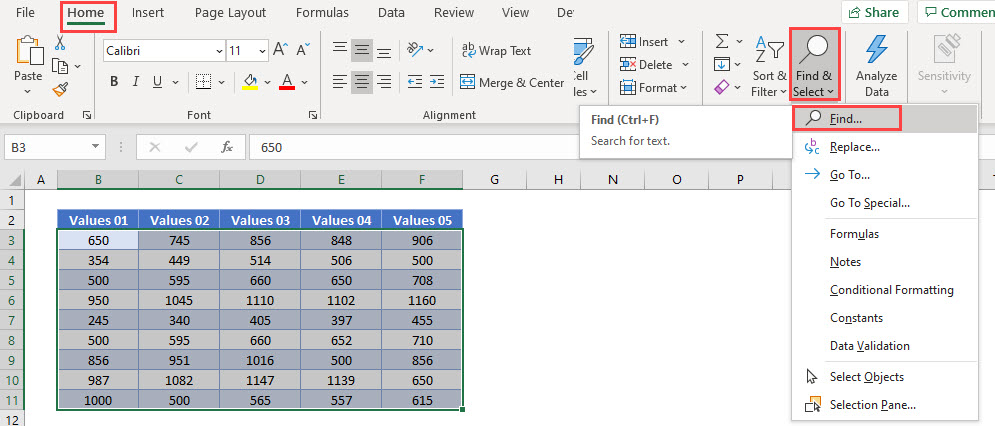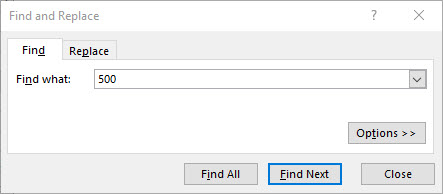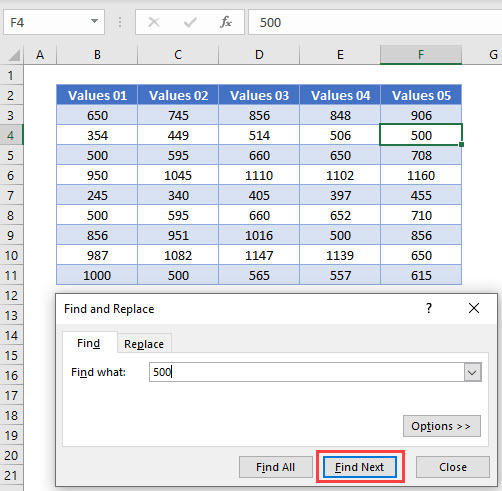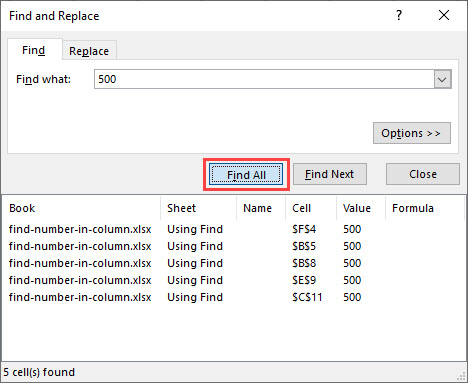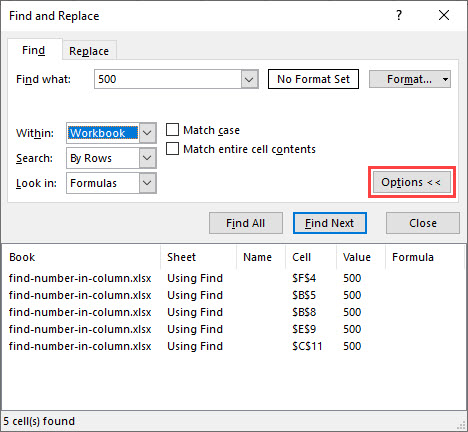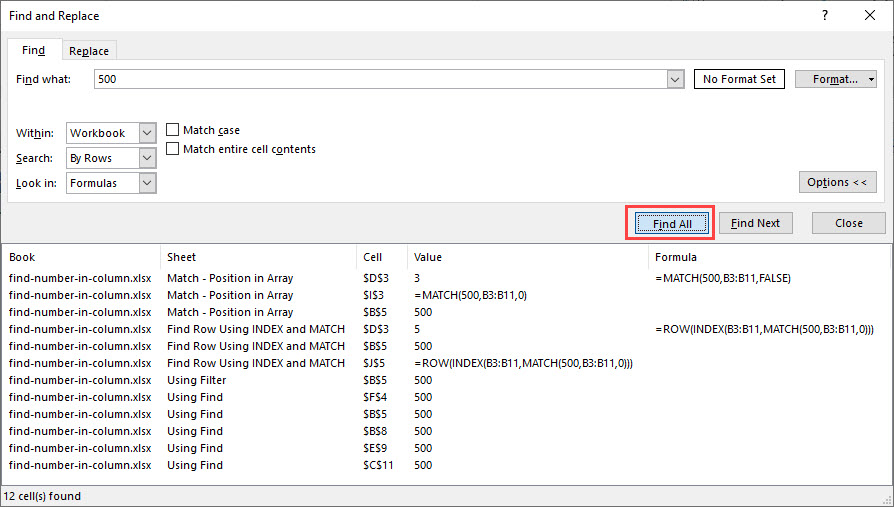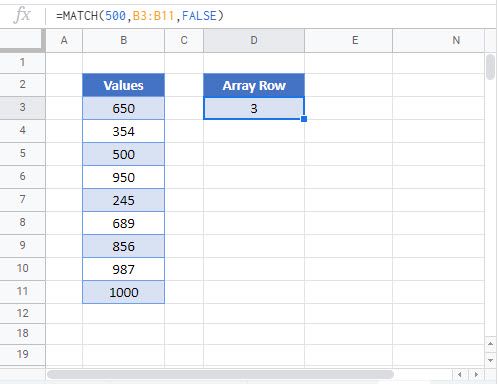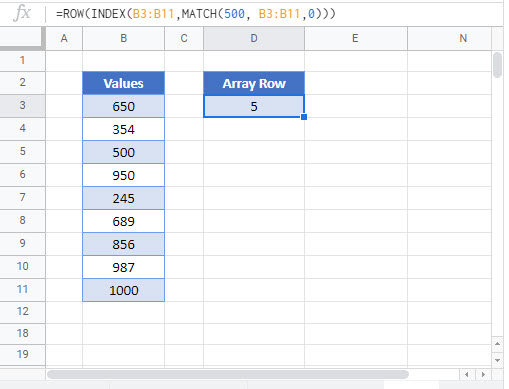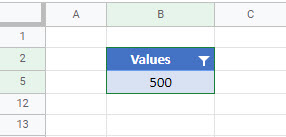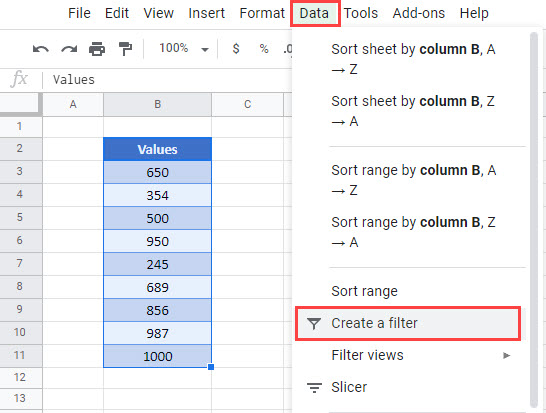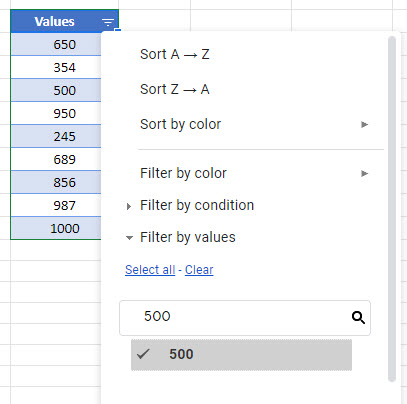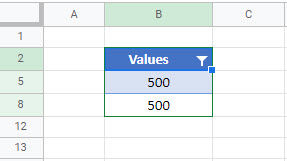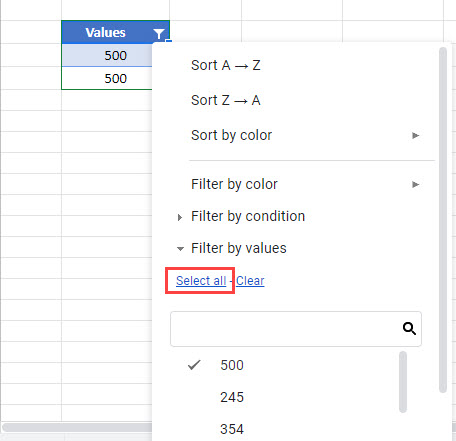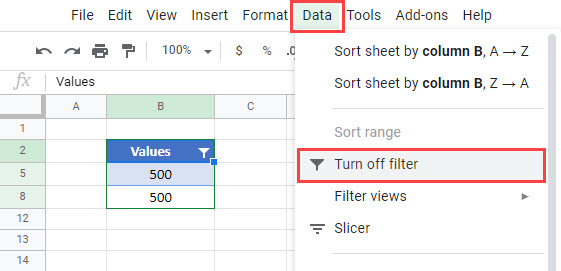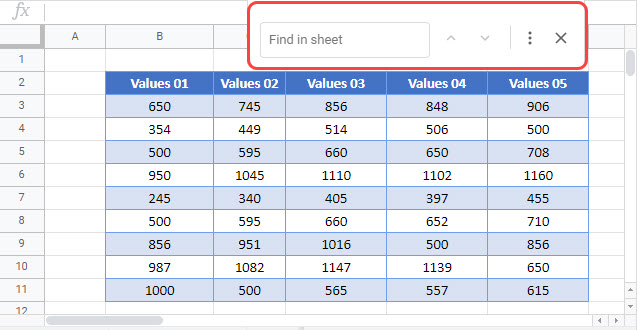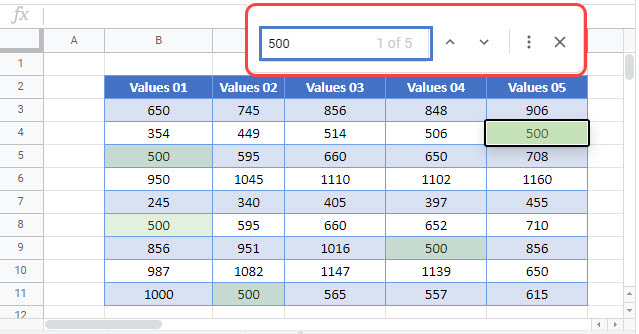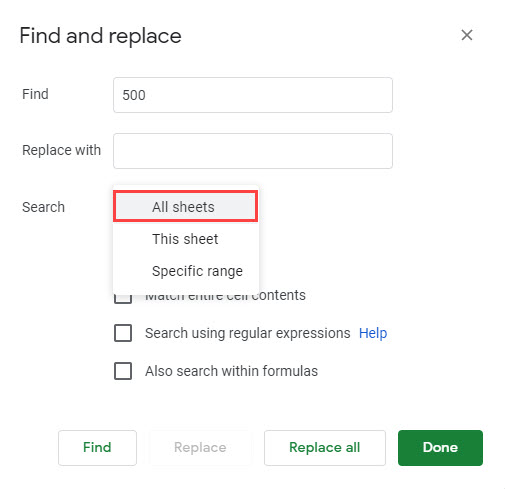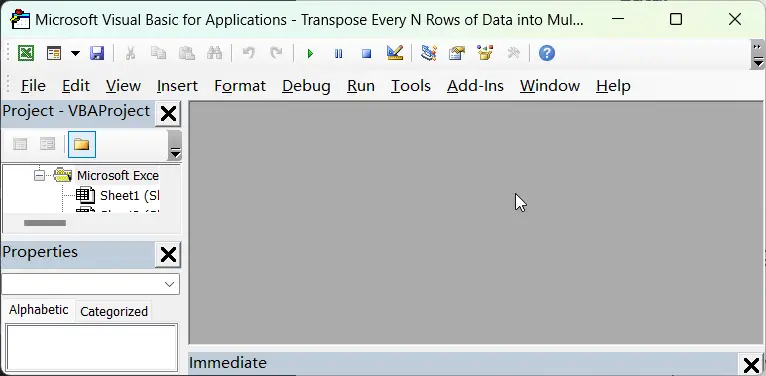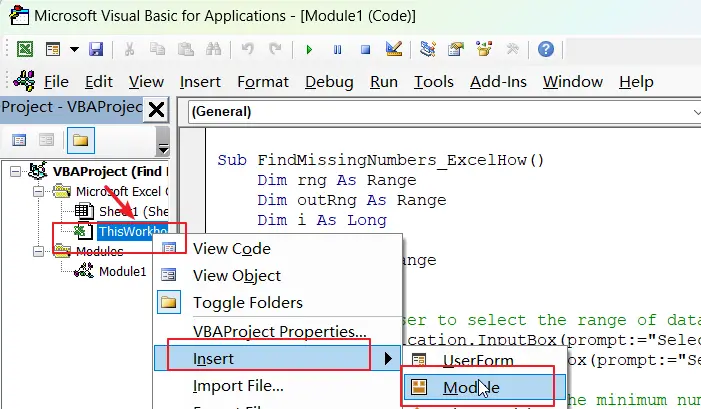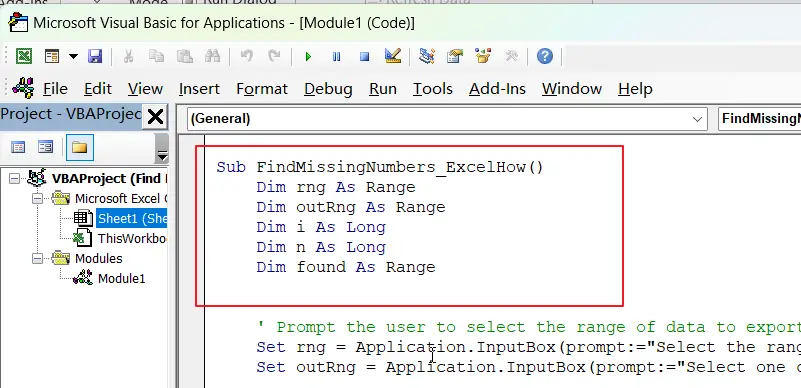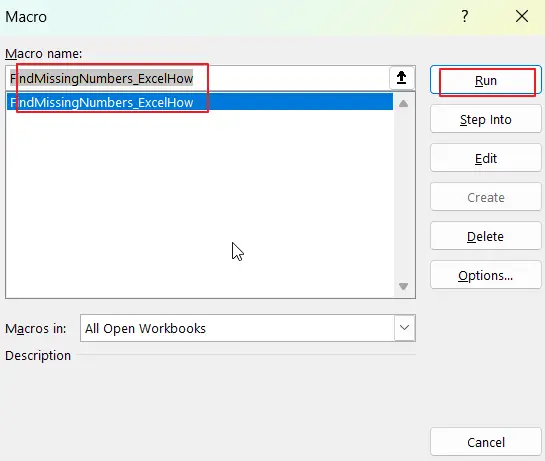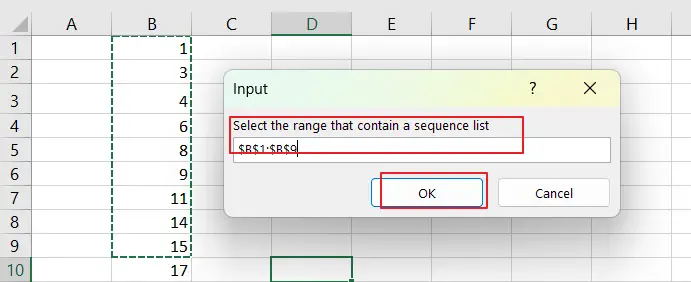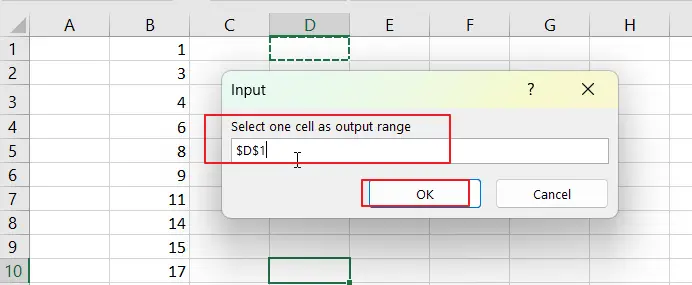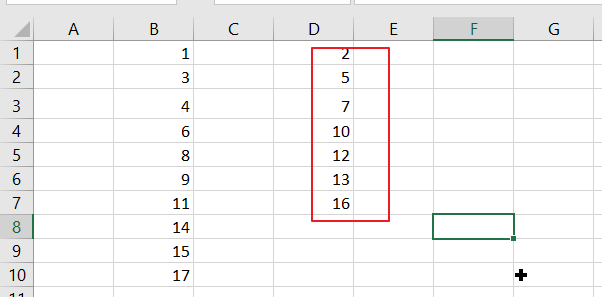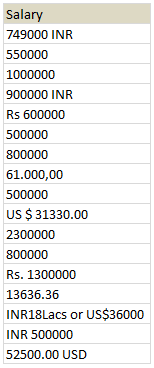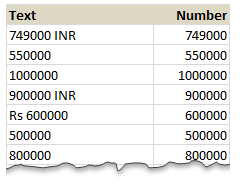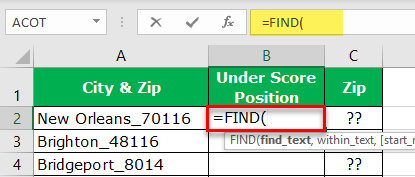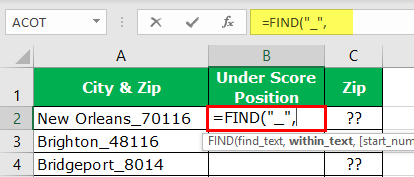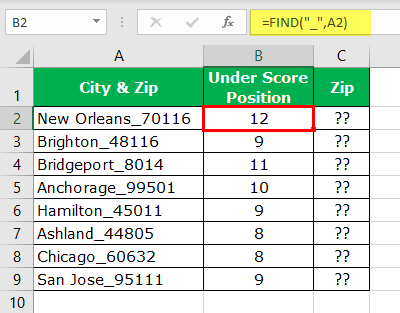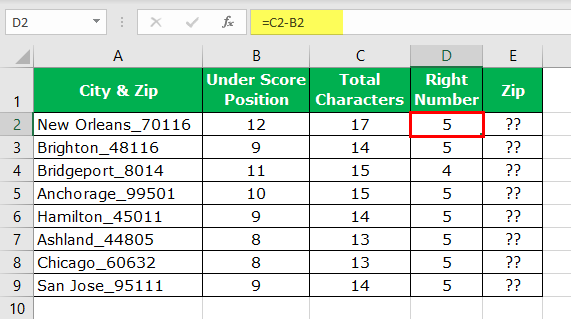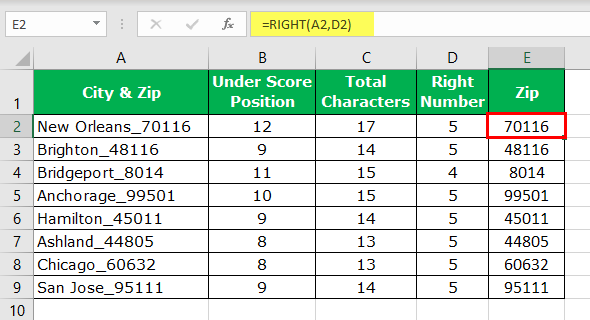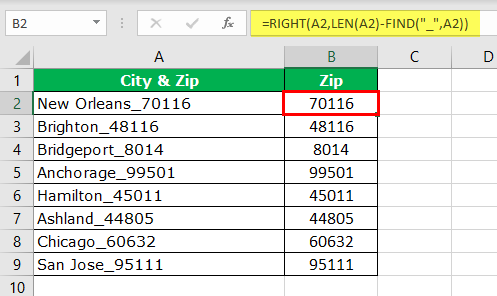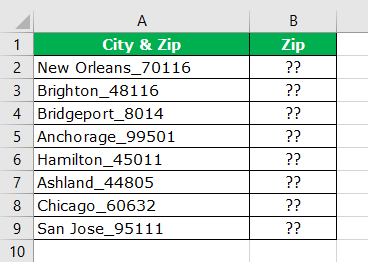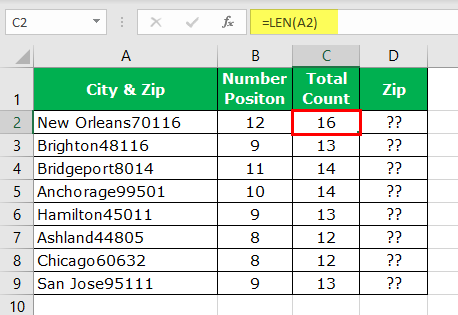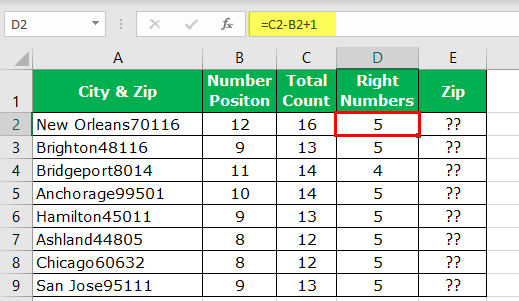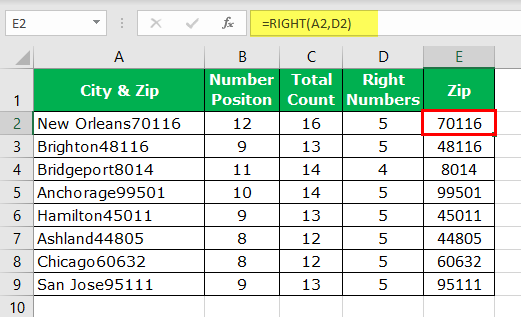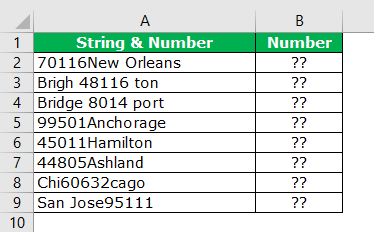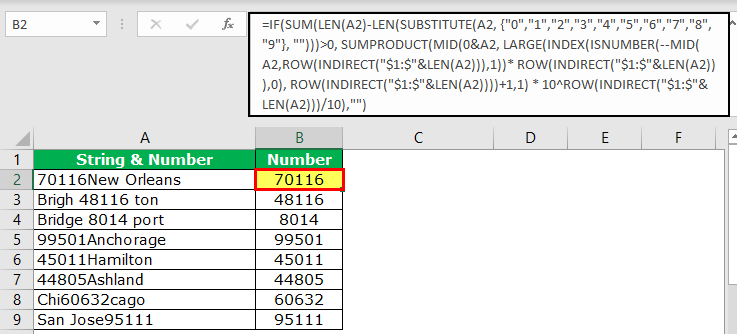
Use the Find and Replace features in Excel to search for something in your workbook, such as a particular number or text string. You can either locate the search item for reference, or you can replace it with something else. You can include wildcard characters such as question marks, tildes, and asterisks, or numbers in your search terms. You can search by rows and columns, search within comments or values, and search within worksheets or entire workbooks.
Find
To find something, press Ctrl+F, or go to Home > Editing > Find & Select > Find.
Note: In the following example, we’ve clicked the Options >> button to show the entire Find dialog. By default, it will display with Options hidden.
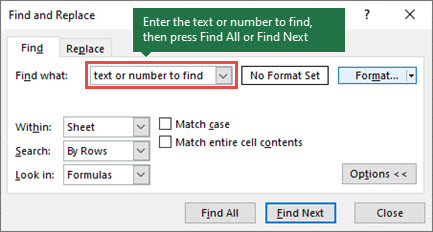
-
In the Find what: box, type the text or numbers you want to find, or click the arrow in the Find what: box, and then select a recent search item from the list.
Tips: You can use wildcard characters — question mark (?), asterisk (*), tilde (~) — in your search criteria.
-
Use the question mark (?) to find any single character — for example, s?t finds «sat» and «set».
-
Use the asterisk (*) to find any number of characters — for example, s*d finds «sad» and «started».
-
Use the tilde (~) followed by ?, *, or ~ to find question marks, asterisks, or other tilde characters — for example, fy91~? finds «fy91?».
-
-
Click Find All or Find Next to run your search.
Tip: When you click Find All, every occurrence of the criteria that you are searching for will be listed, and clicking a specific occurrence in the list will select its cell. You can sort the results of a Find All search by clicking a column heading.
-
Click Options>> to further define your search if needed:
-
Within: To search for data in a worksheet or in an entire workbook, select Sheet or Workbook.
-
Search: You can choose to search either By Rows (default), or By Columns.
-
Look in: To search for data with specific details, in the box, click Formulas, Values, Notes, or Comments.
Note: Formulas, Values, Notes and Comments are only available on the Find tab; only Formulas are available on the Replace tab.
-
Match case — Check this if you want to search for case-sensitive data.
-
Match entire cell contents — Check this if you want to search for cells that contain just the characters that you typed in the Find what: box.
-
-
If you want to search for text or numbers with specific formatting, click Format, and then make your selections in the Find Format dialog box.
Tip: If you want to find cells that just match a specific format, you can delete any criteria in the Find what box, and then select a specific cell format as an example. Click the arrow next to Format, click Choose Format From Cell, and then click the cell that has the formatting that you want to search for.
Replace
To replace text or numbers, press Ctrl+H, or go to Home > Editing > Find & Select > Replace.
Note: In the following example, we’ve clicked the Options >> button to show the entire Find dialog. By default, it will display with Options hidden.
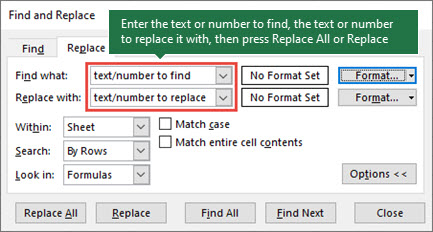
-
In the Find what: box, type the text or numbers you want to find, or click the arrow in the Find what: box, and then select a recent search item from the list.
Tips: You can use wildcard characters — question mark (?), asterisk (*), tilde (~) — in your search criteria.
-
Use the question mark (?) to find any single character — for example, s?t finds «sat» and «set».
-
Use the asterisk (*) to find any number of characters — for example, s*d finds «sad» and «started».
-
Use the tilde (~) followed by ?, *, or ~ to find question marks, asterisks, or other tilde characters — for example, fy91~? finds «fy91?».
-
-
In the Replace with: box, enter the text or numbers you want to use to replace the search text.
-
Click Replace All or Replace.
Tip: When you click Replace All, every occurrence of the criteria that you are searching for will be replaced, while Replace will update one occurrence at a time.
-
Click Options>> to further define your search if needed:
-
Within: To search for data in a worksheet or in an entire workbook, select Sheet or Workbook.
-
Search: You can choose to search either By Rows (default), or By Columns.
-
Look in: To search for data with specific details, in the box, click Formulas, Values, Notes, or Comments.
Note: Formulas, Values, Notes and Comments are only available on the Find tab; only Formulas are available on the Replace tab.
-
Match case — Check this if you want to search for case-sensitive data.
-
Match entire cell contents — Check this if you want to search for cells that contain just the characters that you typed in the Find what: box.
-
-
If you want to search for text or numbers with specific formatting, click Format, and then make your selections in the Find Format dialog box.
Tip: If you want to find cells that just match a specific format, you can delete any criteria in the Find what box, and then select a specific cell format as an example. Click the arrow next to Format, click Choose Format From Cell, and then click the cell that has the formatting that you want to search for.
There are two distinct methods for finding or replacing text or numbers on the Mac. The first is to use the Find & Replace dialog. The second is to use the Search bar in the ribbon.
Find & Replace dialog
Search bar and options
-
Press Ctrl+F or go to Home > Find & Select > Find.
-
In Find what: type the text or numbers you want to find.
-
Select Find Next to run your search.
-
You can further define your search:
-
Within: To search for data in a worksheet or in an entire workbook, select Sheet or Workbook.
-
Search: You can choose to search either By Rows (default), or By Columns.
-
Look in: To search for data with specific details, in the box, click Formulas, Values, Notes, or Comments.
-
Match case — Check this if you want to search for case-sensitive data.
-
Match entire cell contents — Check this if you want to search for cells that contain just the characters that you typed in the Find what: box.
-
Tips: You can use wildcard characters — question mark (?), asterisk (*), tilde (~) — in your search criteria.
-
Use the question mark (?) to find any single character — for example, s?t finds «sat» and «set».
-
Use the asterisk (*) to find any number of characters — for example, s*d finds «sad» and «started».
-
Use the tilde (~) followed by ?, *, or ~ to find question marks, asterisks, or other tilde characters — for example, fy91~? finds «fy91?».
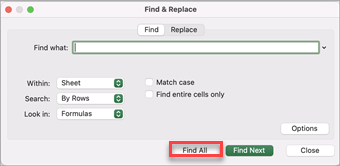
-
Press Ctrl+F or go to Home > Find & Select > Find.
-
In Find what: type the text or numbers you want to find.
-
Select Find All to run your search for all occurrences.
Note: The dialog box expands to show a list of all the cells that contain the search term, and the total number of cells in which it appears.
-
Select any item in the list to highlight the corresponding cell in your worksheet.
Note: You can edit the contents of the highlighted cell.
-
Press Ctrl+H or go to Home > Find & Select > Replace.
-
In Find what, type the text or numbers you want to find.
-
You can further define your search:
-
Within: To search for data in a worksheet or in an entire workbook, select Sheet or Workbook.
-
Search: You can choose to search either By Rows (default), or By Columns.
-
Match case — Check this if you want to search for case-sensitive data.
-
Match entire cell contents — Check this if you want to search for cells that contain just the characters that you typed in the Find what: box.
Tips: You can use wildcard characters — question mark (?), asterisk (*), tilde (~) — in your search criteria.
-
Use the question mark (?) to find any single character — for example, s?t finds «sat» and «set».
-
Use the asterisk (*) to find any number of characters — for example, s*d finds «sad» and «started».
-
Use the tilde (~) followed by ?, *, or ~ to find question marks, asterisks, or other tilde characters — for example, fy91~? finds «fy91?».
-
-
-
In the Replace with box, enter the text or numbers you want to use to replace the search text.
-
Select Replace or Replace All.
Tips:
-
When you select Replace All, every occurrence of the criteria that you are searching for is replaced.
-
When you select Replace, you can replace one instance at a time by selecting Next to highlight the next instance.
-
-
Select any cell to search the entire sheet or select a specific range of cells to search.
-
Press Command + F or select the magnifying glass to expand the Search bar and type the text or number you want to find in the search field.
Tips: You can use wildcard characters — question mark (?), asterisk (*), tilde (~) — in your search criteria.
-
Use the question mark (?) to find any single character — for example, s?t finds «sat» and «set».
-
Use the asterisk (*) to find any number of characters — for example, s*d finds «sad» and «started».
-
Use the tilde (~) followed by ?, *, or ~ to find question marks, asterisks, or other tilde characters — for example, fy91~? finds «fy91?».
-
-
Press return.
Notes:
-
To find the next instance of the item you are searching for, press return again or use the Find dialog box and select Find Next.
-
To specify additional search options, select the magnifying glass and select Search in Sheet or Search in Workbook. You can also select the Advanced option, which launches the Find dialog.
Tip: You can cancel a search in progress by pressing ESC.
-
Find
To find something, press Ctrl+F, or go to Home > Editing > Find & Select > Find.
Note: In the following example, we’ve clicked > Search Options to show the entire Find dialog. By default, it will display with Search Options hidden.
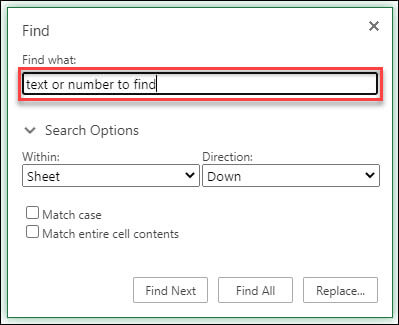
-
In the Find what: box, type the text or numbers you want to find.
Tips: You can use wildcard characters — question mark (?), asterisk (*), tilde (~) — in your search criteria.
-
Use the question mark (?) to find any single character — for example, s?t finds «sat» and «set».
-
Use the asterisk (*) to find any number of characters — for example, s*d finds «sad» and «started».
-
Use the tilde (~) followed by ?, *, or ~ to find question marks, asterisks, or other tilde characters — for example, fy91~? finds «fy91?».
-
-
Click Find Next or Find All to run your search.
Tip: When you click Find All, every occurrence of the criteria that you are searching for will be listed, and clicking a specific occurrence in the list will select its cell. You can sort the results of a Find All search by clicking a column heading.
-
Click > Search Options to further define your search if needed:
-
Within: To search for data within a certain selection, choose Selection. To search for data in a worksheet or in an entire workbook, select Sheet or Workbook.
-
Direction: You can choose to search either Down (default), or Up.
-
Match case — Check this if you want to search for case-sensitive data.
-
Match entire cell contents — Check this if you want to search for cells that contain just the characters that you typed in the Find what box.
-
Replace
To replace text or numbers, press Ctrl+H, or go to Home > Editing > Find & Select > Replace.
Note: In the following example, we’ve clicked > Search Options to show the entire Find dialog. By default, it will display with Search Options hidden.
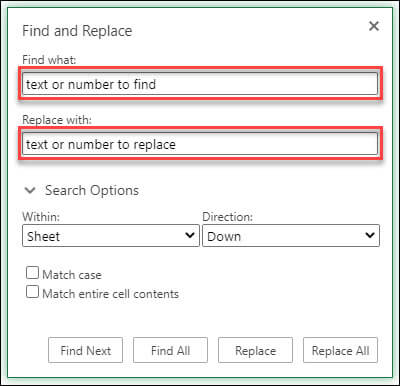
-
In the Find what: box, type the text or numbers you want to find.
Tips: You can use wildcard characters — question mark (?), asterisk (*), tilde (~) — in your search criteria.
-
Use the question mark (?) to find any single character — for example, s?t finds «sat» and «set».
-
Use the asterisk (*) to find any number of characters — for example, s*d finds «sad» and «started».
-
Use the tilde (~) followed by ?, *, or ~ to find question marks, asterisks, or other tilde characters — for example, fy91~? finds «fy91?».
-
-
In the Replace with: box, enter the text or numbers you want to use to replace the search text.
-
Click Replace or Replace All.
Tip: When you click Replace All, every occurrence of the criteria that you are searching for will be replaced, while Replace will update one occurrence at a time.
-
Click > Search Options to further define your search if needed:
-
Within: To search for data within a certain selection, choose Selection. To search for data in a worksheet or in an entire workbook, select Sheet or Workbook.
-
Direction: You can choose to search either Down (default), or Up.
-
Match case — Check this if you want to search for case-sensitive data.
-
Match entire cell contents — Check this if you want to search for cells that contain just the characters that you typed in the Find what box.
-
Need more help?
You can always ask an expert in the Excel Tech Community or get support in the Answers community.
Recommended articles
Merge and unmerge cells
REPLACE, REPLACEB functions
Apply data validation to cells
To find something, press Ctrl+F, or go to Home > Find & Select > Find. In the Find what: box, type the text or numbers you want to find. Click Find Next to run your search.
Contents
- 1 Why can’t I find numbers in Excel?
- 2 How do I get numbers from a cell in Excel?
- 3 How do you pull only numbers from a cell?
- 4 How do you find a number in a string?
- 5 How do you search in numbers?
- 6 How do I find the 4 digit number in Excel?
- 7 Is number formula excel?
- 8 What does this regex do?
- 9 Can I convert a char to an int?
- 10 How do I use Isdigit?
- 11 How do I get 5 digit numbers in Excel?
- 12 How do I extract 5 digit numbers from a cell in Excel?
- 13 How do I sort by last 3 digits in Excel?
- 14 What is number format in Excel?
- 15 How do I convert to numbers in Excel?
- 16 What does S * mean in regex?
- 17 How do you find the regex of a language?
- 18 Why should we use regex?
- 19 How do I convert a char to a string?
- 20 What does char Cannot be Dereferenced mean?
Why can’t I find numbers in Excel?
Ensure that Look In is set to Values and that Match Entire Cell Contents is not checked. Instead of clicking Find, click Find All. Excel adds a new section to the dialog, with a list of all the cells that contain ###. While the focus is still on the dialog, click Ctrl+A.
How do I get numbers from a cell in Excel?
Use the ROW function to number rows
- In the first cell of the range that you want to number, type =ROW(A1). The ROW function returns the number of the row that you reference. For example, =ROW(A1) returns the number 1.
- Drag the fill handle. across the range that you want to fill.
How do you pull only numbers from a cell?
Select all cells with the source strings. On the Extract tool’s pane, select the Extract numbers radio button. Depending on whether you want the results to be formulas or values, select the Insert as formula box or leave it unselected (default).
How do you find a number in a string?
To find whether a given string contains a number, convert it to a character array and find whether each character in the array is a digit using the isDigit() method of the Character class.
How do you search in numbers?
Click View in the toolbar, then choose Show Find & Replace. In the search field, enter the word or phrase you want to find. Matches are highlighted as you enter text. , then choose Whole Words or Match Case (or both).
How do I find the 4 digit number in Excel?
Select a blank cell and type this formula =TEXT(ROW(A1)-1,“0000“) into it, and press Enter key, then drag the autofill handle down until all the 4 digits combinations are listing.
Is number formula excel?
The formula for the ISNUMBER function is “=ISNUMBER (value).” It is a worksheet (WS) function in Excel. It is a Boolean function of Excel which gives the output as “true” or “false.” The ISNUMBER function along with the Excel SEARCH function, checks if a cell contains a specific text among the content of the cell.
What does this regex do?
Short for regular expression, a regex is a string of text that allows you to create patterns that help match, locate, and manage text. Perl is a great example of a programming language that utilizes regular expressions.
Can I convert a char to an int?
We can also use the getNumericValue() method of the Character class to convert the char type variable into int type. Here, as we can see the getNumericValue() method returns the numeric value of the character. The character ‘5’ is converted into an integer 5 and the character ‘9’ is converted into an integer 9 .
How do I use Isdigit?
The isdigit(c) is a function in C which can be used to check if the passed character is a digit or not. It returns a non-zero value if it’s a digit else it returns 0. For example, it returns a non-zero value for ‘0’ to ‘9’ and zero for others. The isdigit() is declared inside ctype.
How do I get 5 digit numbers in Excel?
Steps
- Select the cell or range of cells that you want to format.
- Press Ctrl+1 to load the Format Cells dialog.
- Select the Number tab, then in the Category list, click Custom and then, in the Type box, type the number format, such as 000-00-0000 for a social security number code, or 00000 for a five-digit postal code.
From the Excel file hit Alt + F11 , then go to Tools => Reference and select “Microsoft VBScript Regular Expression 5.5”. which take the value of cell A1 and extract the 5 digits numer, thn the result is saved into cell A2.
How do I sort by last 3 digits in Excel?
Sort by last character or number with Right Function
- Select a blank cell besides the column, says Cell B2, enter the formula of =RIGHT(A2,1), and then drag the cells’s Fill Handle down to the cells as you need.
- Keep selecting these formula cells, and click Data > Sort A to Z or Sort Z to A.
- Now data has been sorted.
What is number format in Excel?
You can use number formats to change the appearance of numbers, including dates and times, without changing the actual number. The number format does not affect the cell value that Excel uses to perform calculations. The actual value is displayed in the formula bar. Excel provides several built-in number formats.
How do I convert to numbers in Excel?
Convert Text to Numbers Using ‘Convert to Number’ Option
- Select all the cells that you want to convert from text to numbers.
- Click on the yellow diamond shape icon that appears at the top right. From the menu that appears, select ‘Convert to Number’ option.
What does S * mean in regex?
s*,s* It says zero or more occurrence of whitespace characters, followed by a comma and then followed by zero or more occurrence of whitespace characters. These are called short hand expressions. You can find similar regex in this site: http://www.regular-expressions.info/shorthand.html.
How do you find the regex of a language?
Regular Expressions
- ɸ is a regular expression for regular language ɸ.
- ɛ is a regular expression for regular language {ɛ}.
- If a ∈ Σ (Σ represents the input alphabet), a is regular expression with language {a}.
- If a and b are regular expression, a + b is also a regular expression with language {a,b}.
Why should we use regex?
Regular Expressions, also known as Regex, come in handy in a multitude of text processing scenarios. Regex defines a search pattern using symbols and allows you to find matches within strings. Most text editors also allow you to use Regex in Find and Replace matches in your code.
How do I convert a char to a string?
Java char to String Example: Character. toString() method
- public class CharToStringExample2{
- public static void main(String args[]){
- char c=’M’;
- String s=Character.toString(c);
- System.out.println(“String is: “+s);
- }}
What does char Cannot be Dereferenced mean?
4. 25. The type char is a primitive — not an object — so it cannot be dereferenced. Dereferencing is the process of accessing the value referred to by a reference. Since a char is already a value (not a reference), it can not be dereferenced.
Содержание
- Find or replace text and numbers on a worksheet
- Replace
- Use Excel built-in functions to find data in a table or a range of cells
- Summary
- Create the Sample Worksheet
- Term Definitions
- Functions
- LOOKUP()
- VLOOKUP()
- INDEX() and MATCH()
- OFFSET() and MATCH()
- Find and Extract Number from String – Excel & Google Sheets
- Find and Extract Number from String
- TEXTJOIN – Extract Numbers in Excel 2016+
- Extract Numbers – Before Excel 2016
- Find Fist Number
- Find First Text Character After Number
- Extract Number From Two Texts
- Other Method
- Find and Extract Number from String to Text in Google Sheets
Find or replace text and numbers on a worksheet

Use the Find and Replace features in Excel to search for something in your workbook, such as a particular number or text string. You can either locate the search item for reference, or you can replace it with something else. You can include wildcard characters such as question marks, tildes, and asterisks, or numbers in your search terms. You can search by rows and columns, search within comments or values, and search within worksheets or entire workbooks.
Tip: You can also use formulas to replace text. Check out the SUBSTITUTE function or REPLACE, REPLACEB functions to learn more.
To find something, press Ctrl+F, or go to Home > Editing > Find & Select > Find.
Note: In the following example, we’ve clicked the Options >> button to show the entire Find dialog. By default, it will display with Options hidden.
In the Find what: box, type the text or numbers you want to find, or click the arrow in the Find what: box, and then select a recent search item from the list.
Tips: You can use wildcard characters — question mark ( ?), asterisk ( *), tilde (
) — in your search criteria.
Use the question mark (?) to find any single character — for example, s?t finds «sat» and «set».
Use the asterisk (*) to find any number of characters — for example, s*d finds «sad» and «started».
) followed by ?, *, or
to find question marks, asterisks, or other tilde characters — for example, fy91
Click Find All or Find Next to run your search.
Tip: When you click Find All, every occurrence of the criteria that you are searching for will be listed, and clicking a specific occurrence in the list will select its cell. You can sort the results of a Find All search by clicking a column heading.
Click Options>> to further define your search if needed:
Within: To search for data in a worksheet or in an entire workbook, select Sheet or Workbook.
Search: You can choose to search either By Rows (default), or By Columns.
Look in: To search for data with specific details, in the box, click Formulas, Values, Notes, or Comments.
Note: Formulas, Values, Notes and Comments are only available on the Find tab; only Formulas are available on the Replace tab.
Match case — Check this if you want to search for case-sensitive data.
Match entire cell contents — Check this if you want to search for cells that contain just the characters that you typed in the Find what: box.
If you want to search for text or numbers with specific formatting, click Format, and then make your selections in the Find Format dialog box.
Tip: If you want to find cells that just match a specific format, you can delete any criteria in the Find what box, and then select a specific cell format as an example. Click the arrow next to Format, click Choose Format From Cell, and then click the cell that has the formatting that you want to search for.
Replace
To replace text or numbers, press Ctrl+H, or go to Home > Editing > Find & Select > Replace.
Note: In the following example, we’ve clicked the Options >> button to show the entire Find dialog. By default, it will display with Options hidden.
In the Find what: box, type the text or numbers you want to find, or click the arrow in the Find what: box, and then select a recent search item from the list.
Tips: You can use wildcard characters — question mark ( ?), asterisk ( *), tilde (
) — in your search criteria.
Use the question mark (?) to find any single character — for example, s?t finds «sat» and «set».
Use the asterisk (*) to find any number of characters — for example, s*d finds «sad» and «started».
) followed by ?, *, or
to find question marks, asterisks, or other tilde characters — for example, fy91
In the Replace with: box, enter the text or numbers you want to use to replace the search text.
Click Replace All or Replace.
Tip: When you click Replace All, every occurrence of the criteria that you are searching for will be replaced, while Replace will update one occurrence at a time.
Click Options>> to further define your search if needed:
Within: To search for data in a worksheet or in an entire workbook, select Sheet or Workbook.
Search: You can choose to search either By Rows (default), or By Columns.
Look in: To search for data with specific details, in the box, click Formulas, Values, Notes, or Comments.
Note: Formulas, Values, Notes and Comments are only available on the Find tab; only Formulas are available on the Replace tab.
Match case — Check this if you want to search for case-sensitive data.
Match entire cell contents — Check this if you want to search for cells that contain just the characters that you typed in the Find what: box.
If you want to search for text or numbers with specific formatting, click Format, and then make your selections in the Find Format dialog box.
Tip: If you want to find cells that just match a specific format, you can delete any criteria in the Find what box, and then select a specific cell format as an example. Click the arrow next to Format, click Choose Format From Cell, and then click the cell that has the formatting that you want to search for.
There are two distinct methods for finding or replacing text or numbers on the Mac. The first is to use the Find & Replace dialog. The second is to use the Search bar in the ribbon.
Источник
Use Excel built-in functions to find data in a table or a range of cells
Summary
This step-by-step article describes how to find data in a table (or range of cells) by using various built-in functions in Microsoft Excel. You can use different formulas to get the same result.
Create the Sample Worksheet
This article uses a sample worksheet to illustrate Excel built-in functions. Consider the example of referencing a name from column A and returning the age of that person from column C. To create this worksheet, enter the following data into a blank Excel worksheet.
You will type the value that you want to find into cell E2. You can type the formula in any blank cell in the same worksheet.
Term Definitions
This article uses the following terms to describe the Excel built-in functions:
The whole lookup table
The value to be found in the first column of Table_Array.
Lookup_Array
-or-
Lookup_Vector
The range of cells that contains possible lookup values.
The column number in Table_Array the matching value should be returned for.
3 (third column in Table_Array)
Result_Array
-or-
Result_Vector
A range that contains only one row or column. It must be the same size as Lookup_Array or Lookup_Vector.
A logical value (TRUE or FALSE). If TRUE or omitted, an approximate match is returned. If FALSE, it will look for an exact match.
This is the reference from which you want to base the offset. Top_Cell must refer to a cell or range of adjacent cells. Otherwise, OFFSET returns the #VALUE! error value.
This is the number of columns, to the left or right, that you want the upper-left cell of the result to refer to. For example, «5» as the Offset_Col argument specifies that the upper-left cell in the reference is five columns to the right of reference. Offset_Col can be positive (which means to the right of the starting reference) or negative (which means to the left of the starting reference).
Functions
LOOKUP()
The LOOKUP function finds a value in a single row or column and matches it with a value in the same position in a different row or column.
The following is an example of LOOKUP formula syntax:
The following formula finds Mary’s age in the sample worksheet:
The formula uses the value «Mary» in cell E2 and finds «Mary» in the lookup vector (column A). The formula then matches the value in the same row in the result vector (column C). Because «Mary» is in row 4, LOOKUP returns the value from row 4 in column C (22).
NOTE: The LOOKUP function requires that the table be sorted.
For more information about the LOOKUP function, click the following article number to view the article in the Microsoft Knowledge Base:
VLOOKUP()
The VLOOKUP or Vertical Lookup function is used when data is listed in columns. This function searches for a value in the left-most column and matches it with data in a specified column in the same row. You can use VLOOKUP to find data in a sorted or unsorted table. The following example uses a table with unsorted data.
The following is an example of VLOOKUP formula syntax:
The following formula finds Mary’s age in the sample worksheet:
The formula uses the value «Mary» in cell E2 and finds «Mary» in the left-most column (column A). The formula then matches the value in the same row in Column_Index. This example uses «3» as the Column_Index (column C). Because «Mary» is in row 4, VLOOKUP returns the value from row 4 in column C (22).
For more information about the VLOOKUP function, click the following article number to view the article in the Microsoft Knowledge Base:
INDEX() and MATCH()
You can use the INDEX and MATCH functions together to get the same results as using LOOKUP or VLOOKUP.
The following is an example of the syntax that combines INDEX and MATCH to produce the same results as LOOKUP and VLOOKUP in the previous examples:
The following formula finds Mary’s age in the sample worksheet:
The formula uses the value «Mary» in cell E2 and finds «Mary» in column A. It then matches the value in the same row in column C. Because «Mary» is in row 4, the formula returns the value from row 4 in column C (22).
NOTE: If none of the cells in Lookup_Array match Lookup_Value («Mary»), this formula will return #N/A.
For more information about the INDEX function, click the following article number to view the article in the Microsoft Knowledge Base:
OFFSET() and MATCH()
You can use the OFFSET and MATCH functions together to produce the same results as the functions in the previous example.
The following is an example of syntax that combines OFFSET and MATCH to produce the same results as LOOKUP and VLOOKUP:
This formula finds Mary’s age in the sample worksheet:
The formula uses the value «Mary» in cell E2 and finds «Mary» in column A. The formula then matches the value in the same row but two columns to the right (column C). Because «Mary» is in column A, the formula returns the value in row 4 in column C (22).
For more information about the OFFSET function, click the following article number to view the article in the Microsoft Knowledge Base:
Источник
Find and Extract Number from String – Excel & Google Sheets
Download the example workbook
This tutorial will demonstrate you how to find and extract a number from inside a text string in Excel and Google Sheets.
Find and Extract Number from String
Sometimes your data may contain numbers and text and you want to extract the numerical data.
If the number part is on the right or left side of the string, it’s relatively easy to split the number and text . However, if the numbers are inside the string, i.e. between two text strings, you will need to use a much more complicated formula (shown below).
In Excel 2016 the TEXTJOIN function was introduced, which can extract the numbers from anywhere of the text string. Here is the formula:
Let’s see how this formula works.
The ROW, INDIRECT and LEN Functions returns an array of numbers corresponding to each character in your alphanumerical string. In our case, “Monday01Day” has 11 characters, so the ROW function will then return the array <1;2;3;4;5;6;7;8;9;10;11>.
Next, the MID Function extracts each character from the text string, creating an array containing your original string:
Multiplying each value in the array by 1 will create an array containing errors If the array character was text:
Next, the IFERROR Function, removes the error values:
Leaving only the TEXTJOIN Function which joins the remaining numbers together.
Note that the formula will give you all the numeric characters together from your string. For example, if your alphanumerical string is Monday01Day01, it will give you 0101 as a result.
Before Excel 2016, you could use a much more complicated method to extract numbers from text. You can use the FIND function together with the IFERROR and MIN functions to determine both the first position of the number part and the first position of the text part after the number. Then we simply extract the number part with the MID function.
Note: This is an Array formula, you must enter the formula by pressing CTRL + SHIFT + ENTER, instead of just ENTER.
Let’s see step by step how this formula works.
Find Fist Number
We can use the FIND function to locate the starting position of the number.
For the find_text argument of the FIND function, we use the array constant <0,1,2,3,4,5,6,7,8,9>, which makes the FIND function to perform a separate search for each value in the array constant.
The within_text argument of the FIND function in our case is Monday01Day, in which 1 can be found at the position 8, and 0 at the position 7, so our result array will be: <8,#VALUE,#VALUE,#VALUE,#VALUE,#VALUE,#VALUE, #VALUE, #VALUE,7>.
Using the IFERROR function we replace the #VALUE errors by 999999999. Then we simply look for the minimum within this array and get therefore the place of the first number (7).
Please note that the above formula is an array formula, you have to press Ctrl+Shift+Enter to trigger it.
Find First Text Character After Number
Similarly to locating the first number within the string, we use the FIND function to determine where the text begins again after the number making good use also of the start_num argument of the function.
This formula works very similarly to the previous one used for locating the first number, only we use letters in our array constant and therefore numbers cause #VALUE errors. Please note that we start searching only after the position determined for the first number (this will be the start_num argument) and not from the beginning of the string.
Don’t forget to press Ctrl+Shift+Enter to use of the above formula.
There is nothing left than putting this all together.
Once we have the starting position of the number part and the beginning of the text part after that, we simply use the MID function to extract the desired number part.
Other Method
Without explaining it in more detail, you can also use the below complex formula to get the number from inside a string.
Please be aware that this formula above will give you 0 when there is no number found in the string and that leading zeros will be left out.
Find and Extract Number from String to Text in Google Sheets
The examples shown above work the same way in Google Sheets as they do in Excel.
Источник
Return to Excel Formulas List
Download Example Workbook
Download the example workbook
This tutorial will demonstrate how to find a number in a column or workbook in Excel and Google Sheets.
Find a Number in a Column
The MATCH Function is useful when you want to find a number within a array of values.
This example will find 500 in column B.
=MATCH(500,B3:B11, 0)The position of 500 is the 3rd value in the range and returns 3.
Find Row Number of Value Using ROW, INDEX and MATCH Functions
To find the row number of the value found, we can add the ROW and INDEX functions to the MATCH Function.
=ROW(INDEX(B3:B11,MATCH(987,B3:B11,0)))ROW and INDEX Functions
The MATCH Function returns 3 as we have seen from the previous example. The INDEX Function will then return the cell reference or value of the array position returned by the MATCH Function. The ROW function will then return the row of that cell reference.
Filter in Excel
We can find a specific number in an array of data by using a Filter in Excel.
- Click in the Range you want to filter ex B3:B10.
- In the Ribbon, select Home > Editing > Sort & Filter > Filter.
- A drop-down list will be added to the first row in your selected range.
- Click on the drop-down list to get a list of available options.
- Type 500 in the search bar.
- Click OK.
- If your range has more than one value of 500, then both would show.
- The rows that do not contain the required values are hidden, and the visible row headers are shown in BLUE.
- To clear the filter, click on the drop-down and then click Clear Filter From “Values”.
To remove the filter entirely from the Range, select Home > Editing > Sort & Filter > Clear in the Ribbon.
Find Number in Workbook or Worksheet using FIND in Excel
We can look for values in Excel using the FIND functionality.
- In your workbook, press Ctrl+F on the keyboard.
OR
In the Ribbon, select Home > Editing > Find & Select.
- Type in the value you wish to find.
- Click Find Next.
- Continue to click Find Next to move through all the available values in the Worksheet.
- Click Find All to find all the instances of the value in the worksheet.
Click Options.
- Amend the Within from Sheet to Workbook and click Find All
- All the matching values will appear in the results shown.
Find a Number – MATCH Function in Google Sheets
The MATCH Function works the same in Google Sheets as it does in Excel.
Find Row Number of Value Using ROW, INDEX and MATCH Functions in Google Sheets
The ROW, INDEX and MATCH Functions works the same in Google Sheets as it does in Excel.
Filter in Google Sheets
We can find a specific number in an array of data by using Filter in Google Sheets.
- Click in the Range you want to filter ex B3:B10.
- In the Menu, select Data > Create a filter
- In the Search bar, type in the value you wish to filter on.
- Click OK.
- If your range has more than one value of 500, then both would show.
- The rows that do not contain the required values are hidden.
- To clear the filter, click on the drop-down, click Select All” and then click
To remove the filter entire, in the Menu, select Data > Turn off Filter.
Find Number in Workbook or Worksheet using FIND in Google Sheets
We can look for values in Google Sheets using the FIND functionality.
- In your workbook, press Ctrl+F on the keyboard.
- Type in the value you wish to find.
- All the matching values in the current sheet will be highlighted, with the first one being selected as shown below.
- Select More Options.
- Amend the search to All Sheets.
- Click Find.
- The first instance of the value will be found. Click Find again to go to the next value and continue to click Find to find all the matching values in the workbook.
- Click Done to exit out of the Find and Replace Dialog Box.
In this example, the goal is to test the passwords in column B to see if they contain a number. This is a surprisingly tricky problem because Excel doesn’t have a function that will let you test for a number inside a text string directly. Note this is different from checking if a cell value is a number. You can easily perform that test with the ISNUMBER function. In this case, however, we to test if a cell value contains a number, which may occur anywhere. One solution is to use the FIND function with an array constant. In Excel 365, which supports dynamic array formulas, you can use a different formula based on the SEQUENCE function. Both approaches are explained below.
FIND function
The FIND function is designed to look inside a text string for a specific substring. If FIND finds the substring, it returns a position of the substring in the text as a number. If the substring is not found, FIND returns a #VALUE error. For example:
=FIND("p","apple") // returns 2
=FIND("z","apple") // returns #VALUE!We can use this same idea to check for numbers as well:
=FIND(3,"app637") // returns 5
=FIND(9,"app637") // returns #VALUE!The challenge in this case is that we need to check the values in column B for ten different numbers, 0-9. One way to do that is to supply these numbers as the array constant {0,1,2,3,4,5,6,7,8,9}. This is the approach taken in the formula in cell D5:
=COUNT(FIND({0,1,2,3,4,5,6,7,8,9},B5))>0Inside the COUNT function, the FIND function is configured to look for all ten numbers in cell B5:
FIND({0,1,2,3,4,5,6,7,8,9},B5)Because we are giving FIND ten values to look for, it returns an array with 10 results. In other words, FIND checks the text in B5 for each number and returns all results at once:
{#VALUE!,4,5,6,#VALUE!,#VALUE!,#VALUE!,#VALUE!,#VALUE!,#VALUE!}Unless you look at arrays often, this may look pretty cryptic. Here is the translation: The number 1 was found at position 4, the number 2 was found at position 5, and the number 3 was found at position 6. All other numbers were not found and returned #VALUE errors.
We are very close now to a final formula. We simply need to tally up results. To do this, we nest the FIND formula above inside the COUNT function like this:
=COUNT(FIND({0,1,2,3,4,5,6,7,8,9},B5))FIND returns the array of results directly to COUNT, which counts the numbers in the array. COUNT only counts numeric values, and ignores errors. This means COUNT will return a number greater than zero if there are any numbers in the value being tested. In the case of cell B5, COUNT returns 3.
The last step is to check the result from COUNT and force a TRUE or FALSE result. We do this by adding «>0» to the end of formula:
=COUNT(FIND({0,1,2,3,4,5,6,7,8,9},B5))>0Now the formula will return TRUE or FALSE. To display a custom result, you can use the IF function:
=IF(COUNT(FIND({0,1,2,3,4,5,6,7,8,9},B5))>0, "Yes", "No")
The original formula is now nested inside IF as the logical_test argument. This formula will return «Yes» if B5 contains a number and «No» if not.
SEQUENCE function
In Excel 365, which offers dynamic array formulas, we can take a different approach to this problem.
=COUNT(--MID(B5,SEQUENCE(LEN(B5)),1))>0This isn’t necessarily a better approach, just a different way to solve the same problem. At the core, this formula uses the MID function together with the SEQUENCE function to split the text in cell B5 into an array:
MID(B5,SEQUENCE(LEN(B5)),1)Working from the inside out, the LEN function returns the length of the text in cell B5:
LEN(B5) // returns 6This number is returned to the SEQUENCE function as the rows argument, and SEQUENCE returns an array of numbers, 1-6:
=SEQUENCE(LEN(B5))
=SEQUENCE(6)
={1;2;3;4;5;6}This array is returned to the MID function as the start_num argument, and, with num_chars set to 1, the MID function returns an array that contains the characters in cell B5:
=MID(B5,{1;2;3;4;5;6},1)
={"a";"b";"c";"1";"2";"3"}We can now simplify the original formula to:
=COUNT(--{"a";"b";"c";"1";"2";"3"})>0We use the double-negative (—) to get Excel to try and coerce the values in the array into numbers. The result looks like this:
=COUNT({#VALUE!;#VALUE!;#VALUE!;1;2;3})>0The math operation created by the double negative (—) returns an actual number when successful and a #VALUE! error when the operation fails. The COUNT function counts the numbers, ignoring any errors, and returns 3. As above, we check the final count with «>0», and the result for cell B5 is TRUE.
Note: as you might guess, you can easily adapt this formula to count numbers in a text string.
Cell equals number?
Note that the formulas above are too complex if you only want to test if a cell equals a number. In that case, you can simply use the ISNUMBER function like this:
=ISNUMBER(A1)
If you’re working with data in Excel and notice that there are some missing numbers in a sequence, it can be frustrating to try and figure out where they are. Fortunately, there are a few ways to find these missing numbers quickly and easily.
This post will guide you how to find missing numbers in a sequence with a formula in Excel. How do I identify missing numbers in a consecutive series in Excel. How to find missing serial number in Excel 2013/2016.
This post will guide you through two methods to find missing numbers in a sequence in Excel: using a formula and using VBA code.
Table of Contents
- 1. Find Missing Numbers in a Sequence in Excel
- 2. Find Missing Numbers in a Sequence using VBA Code in Excel
- 3. Video: Find Missing Numbers in a Sequence in Excel
- 4. Related Functions
Assuming that you have a serial number list in Column B, and you want to find the missing number in this sequence list. How to achieve it.
You can use an excel array formula based on the SMALL function, the IF function, the ISNA function, the MATCH function, and the ROW function. Like this:
=SMALL(IF(ISNA(MATCH(ROW(B$1:B$20),B$1:B$20,0)),ROW(B$1:B$20)),ROW(B1))Type this array formula into a blank cell, and then press Ctrl + Shift + Enter keys in your keyboard.
The missing numbers are listed in cells.
Or you can use another array formula based on the Small function, the IF function, the Countif function and the row function to achieve the same result. Like this:
=SMALL(IF(COUNTIF($B$1:$B$10,ROW($1:$20))=0,ROW($1:$20),""),ROW(B1))2. Find Missing Numbers in a Sequence using VBA Code in Excel
To find missing numbers in a sequence in Excel with VBA code, you can follow these steps:
Step1: Press Alt + F11 to open the Visual Basic Editor (VBE) or click Developer > Visual Basic.
Step2: In the VBE window, right-click your workbook and click Insert > Module.
Step3: In the module window, paste the following code:
Sub FindMissingNumbers_ExcelHow()
Dim rng As Range
Dim outRng As Range
Dim i As Long
Dim n As Long
Dim found As Range
' Prompt the user to select the range of data to export
Set rng = Application.InputBox(prompt:="Select the range that contain a sequence list", Type:=8)
Set outRng = Application.InputBox(prompt:="Select one cell as output range", Type:=8)
n = Application.Min(rng) 'get the minimum number in the input range
For i = 1 To Application.Max(rng) - n + 1 '
Set found = rng.Find(n, LookIn:=xlValues, LookAt:=xlWhole)
If found Is Nothing Then
outRng.Value = n
Set outRng = outRng.Offset(1)
End If
n = n + 1
Next i
End Sub
Step4: Press ALT + F8 on your keyboard to open the Macro dialog box. Select the FindMissingNumbers_ExcelHow macro from the list and click the Run button.
Step5: Select one range of cells that contains a sequence to find missing numbers.
Step6: Select one cell as output range to place the missing numbers.
Step7: The missing numbers in the sequence will be listed in the output range.
3. Video: Find Missing Numbers in a Sequence in Excel
This video will demonstrate both a formula and VBA code to help you find missing numbers in a sequence in Excel.
- Excel MATCH function
The Excel MATCH function search a value in an array and returns the position of that item.The syntax of the MATCH function is as below:= MATCH (lookup_value, lookup_array, [match_type])…. - Excel SMALL function
The Excel SMALL function returns the smallest numeric value from the numbers that you provided. Or returns the smallest value in the array.The syntax of the SMALL function is as below:=SMALL(array,nth) … - Excel ROW function
The Excel ROW function returns the row number of a cell reference.The ROW function is a build-in function in Microsoft Excel and it is categorized as a Lookup and Reference Function.The syntax of the ROW function is as below:= ROW ([reference])…. - Excel IF function
The Excel IF function perform a logical test to return one value if the condition is TRUE and return another value if the condition is FALSE. The IF function is a build-in function in Microsoft Excel and it is categorized as a Logical Function.The syntax of the IF function is as below:= IF (condition, [true_value], [false_value])…. - Excel COUNTIF function
The Excel COUNTIF function will count the number of cells in a range that meet a given criteria. This function can be used to count the different kinds of cells with number, date, text values, blank, non-blanks, or containing specific characters.etc.= COUNTIF (range, criteria)…
Extracting numbers from a list of cells with mixed text is a common data cleaning task.
Unfortunately, there is no direct menu or function created in Excel to help us accomplish this.
In this tutorial we will look at three cases where you might have a list of mixed text, from which you might want to extract numbers:
- When the number is always at the end of the text
- When the number is always at the beginning of the text
- When the number can be anywhere in the text
We will look at three different formulas that can be used to extract the numbers in each case.
At the end of the tutorial, we will also take a look at some VBA code that you can use to accomplish the same.
Brace yourself, this might get a little complex!
Extracting a Number from Mixed Text when Number is Always at the End of the Text
Consider the following example:

Here, each cell has a mix of text and numbers, with the number always appearing at the end of the text. In such cases, we will need to use a combination of nested Excel functions to extract the numbers.
The functions we will use are:
- FIND – This function searches for a character or string in another string and returns its position.
- MIN – This function returns the smallest value in a list.
- LEFT – This function extracts a given number of characters from the left side of a string.
- SUBSTITUTE – This function replaces a particular substring of a given text with another substring.
- IFERROR – This function returns an alternative result or formula if it finds an error in a given formula.
Essentially, we will be using the above functions altogether to perform the following sequence of tasks:
- Find the position of the first numeric value in the given cell
- Extract and remove the text part of the given cell (by removing everything to the left of the first numeric digit)
The formula that we will use to extract the numbers from cell A2 is as follows:
=SUBSTITUTE(A2,LEFT(A2,MIN(IFERROR(FIND({0,1,2,3,4,5,6,7,8,9},A2),""))-1),"")
Let us break down this formula to understand it better. We will go from the inner functions to the outer functions:
- FIND({0,1,2,3,4,5,6,7,8,9},A2)
This function tries to find the positions of all the numbers (0-9) in the cell A2. Thus it returns an arrayformula:
{#VALUE!,#VALUE!,#VALUE!,#VALUE!,#VALUE!,#VALUE!,9,7,8,#VALUE!}
It returns a #VALUE! error for all digits except the 7th, 8th, and 9th digits because it was not able to find these numbers (0,1,2,3,4,5,9) in cell A2. It simply returns the positions of numbers 6,7 and 8 which are the 9th, 7th, and 8th characters respectively in A2.
- IFERROR(FIND({0,1,2,3,4,5,6,7,8,9},A2),””)
Next, the IFERROR function replaces all the error elements of the array with a blank (“”). As such it returns the arrayformula:
{“”,””,””,””,””,””,9,7,8,””}
- MIN(IFERROR(FIND({0,1,2,3,4,5,6,7,8,9},A2),””))
After this the MIN function finds the array element with least value. This is basically the position of the first numeric character in A2. The function now returns the value 7.
- LEFT(A2,MIN(IFERROR(FIND({0,1,2,3,4,5,6,7,8,9},A2),””))-1)
At this point we want to extract all text characters from A2 (so that we can remove them). So we want the LEFT function to extract all the characters starting backwards from the 7-1= 6th character. Thus we use the above formula. The result we get at this point is “arnold”. Notice we subtracted 1 from the second parameter of the LEFT function.
- SUBSTITUTE(A2,LEFT(A2,MIN(IFERROR(FIND({0,1,2,3,4,5,6,7,8,9},A2),””))-1),””)
Now all that’s left to do is remove the string obtained, by replacing it with a blank. This can be easily achieved by using the SUBSTITUTE function: We finally get the numeric characters in the mixed text, which is “786”.
Once you are done entering the formula, make sure you press CTRL+SHIFT+Enter, instead of just the return key. This is because the formula involves arrays.
In a nutshell, here’s what’s happening when you break down the formula:
=SUBSTITUTE(A2,LEFT(A2,MIN(IFERROR(FIND({0,1,2,3,4,5,6,7,8,9},A2),””))-1),””)
=SUBSTITUTE(A2,LEFT(A2,MIN(IFERROR({{#VALUE!,#VALUE!,#VALUE!,#VALUE!,#VALUE!,#VALUE!,9,7,8,#VALUE!}),””))-1),””)
=SUBSTITUTE(A2,LEFT(A2,MIN({“”,””,””,””,””,””,9,7,8,””}))-1),””)
=SUBSTITUTE(A2,”arnold”,””)
=786
When you drag the formula down to the rest of the cells, here’s the result you get:

Also read: How to Generate Random Letters in Excel?
Extracting a Number from Mixed Text when Number is Always at the Beginning of the Text
Now let us consider the case where the numbers are always at the beginning of the Text.
Consider the following example:

Here, each cell has a mix of text and numbers, with the number always appearing at the beginning of the text. In such cases, we will again need to use a combination of nested Excel functions to extract the numbers.
In addition to the functions we used in the previous formula, we are going to use two additional functions. These are:
- MAX – This function returns the largest value in a list
- RIGHT – This function extracts a given number of characters from the right side of a string
- LEN – This function finds the length of (number of characters in) a given string.
Essentially, we will be using these functions altogether to perform the following sequence of tasks:
- Find the position of the last numeric value in the given cell
- Extract and remove the text part of the given cell (by removing everything to the right of the last numeric digit)
The formula that we will use to extract the numbers from cell A2 is as follows:
=SUBSTITUTE(A2,RIGHT(A2,LEN(A2)-MAX(IFERROR(FIND({0,1,2,3,4,5,6,7,8,9},A2),""))),"")
Let us break down this formula to understand it better. We will go from the inner functions to the outer functions:
- FIND({0,1,2,3,4,5,6,7,8,9},A2)
This function tries to find the positions of all the numbers (0-9) in the cell A2. Thus it returns an arrayformula:
{#VALUE!,#VALUE!,1,#VALUE!,#VALUE!,2,#VALUE!,#VALUE!,#VALUE!,#VALUE!}
It returns a #VALUE! error for all digits except the 3rd and 6th digits because it was not able to find these numbers (0,1,3,4,6,7,8,9) in cell A2. It simply returns the positions of numbers 2 and 5 which are the 1st and 2nd characters respectively in A2.
- IFERROR(FIND({0,1,2,3,4,5,6,7,8,9},A2),””)
Next, the IFERROR function replaces all the error elements of the array with a blank. As such it returns the array formula:
{“”,””,1,””,””,2,””,””,””,””}
- MAX(IFERROR(FIND({0,1,2,3,4,5,6,7,8,9},A2),””))
After this the MAX function finds the array element with the highest value. This is basically the position of the last numeric character in A2. The function now returns the value 2.
- LEN(A2)-MAX(IFERROR(FIND({0,1,2,3,4,5,6,7,8,9},A2),””))
At this point we want to extract all text characters from A2 (so that we can remove them). We need to specify how many characters we want to remove. This is obtained by computing the length of the string in A2 minus the position of the last numeric value.Thus we will get the value 8-2 = “6”.
- RIGHT(A2,LEN(A2)-MAX(IFERROR(FIND({0,1,2,3,4,5,6,7,8,9},A2),””)))
We can now use the RIGHT function to extract 6 characters starting from the 2nd character onwards. The result we get at this point is “arnold”.
- SUBSTITUTE(A2,RIGHT(A2,LEN(A2)-MAX(IFERROR(FIND({0,1,2,3,4,5,6,7,8,9},A2),””))),””)
Now all that’s left to do is remove this string by replacing it with a blank. This is easily achieved by using the SUBSTITUTE function. We finally get the numeric characters in the mixed text, which is “25”.
Again, once you are done entering the formula, don’t forget to press CTRL+SHIFT+Enter, instead of just the return key.
In a nutshell, here’s what’s happening when you break down the formula:
=SUBSTITUTE(A7,RIGHT(A7,LEN(A7)-MAX(IFERROR(FIND({0,1,2,3,4,5,6,7,8,9},A7),””))),””)
=SUBSTITUTE(A7,RIGHT(A7,LEN(A7)-MAX(IFERROR({#VALUE!,#VALUE!,1,#VALUE!,#VALUE!,2,#VALUE!,#VALUE!,#VALUE!,#VALUE!}
),””))),””)
=SUBSTITUTE(A7,RIGHT(A7,LEN(A7)-MAX({“”,””,1,””,””,2,””,””,””,””}
)),””)
=SUBSTITUTE(A7,RIGHT(A7,LEN(A7)-2),””)
=SUBSTITUTE(A7,RIGHT(A7,8-2),””)
=SUBSTITUTE(A7,”arnold”,””)
=25
When you drag the formula down to the rest of the cells, here’s the result you get:

Extracting a Number from Mixed Text when Number can be Anywhere in the Text
Finally let us consider the case where the numbers can be anywhere in the text, be it the beginning, end or middle part of the text.
Let’s take a look at the following example:

Here, each cell has a mix of text and numbers, where the number appears in any part of the text. In such cases, we will need to use a combination of nested Excel functions to extract the numbers.
Here are the functions that we are going to use this time:
- INDIRECT – This function simply returns a reference to a range of values.
- ROW – This function returns a row number of a reference.
- MID – This function extracts a given number of characters from the middle of a string.
- TEXTJOIN – This function combines text from multiple ranges or strings using a specified delimiter between them.
Note that the formula discussed in this section will work only in Excel version 2016 onwards as it uses the newly introduced TEXTJOIN function. If you are using an older version of Excel, then you may consider using the VBA method instead (discussed in the next section).
In this method, we will essentially be using the above functions altogether to perform the following sequence of tasks:
- Break up the given text into an array of individual characters
- Find out and remove all characters that are not numbers
- Combine the remaining characters into a full number
The formula that we will use to extract the numbers from cell A2 is as follows:
=TEXTJOIN("",TRUE,IFERROR(MID(A2,ROW(INDIRECT("1:"&LEN(A2))),1)*1,""))
Let us break down this formula to understand it better. We will go from the inner functions to the outer functions:
- LEN(A2)
This function finds the length of the string in cell A2. In our case it returns 13.
- INDIRECT(“1:”&LEN(A2))
This function just returns a reference to all the rows from row 1 to row 12.
- ROW(INDIRECT(“1:”&LEN(A2)))
Now this function returns the row numbers of each of these rows. In other words, it simply returns an array of numbers 1 to 12. This function thus returns the array:
{1;2;3;4;5;6;7;8;9;10;11;12;13}
Note: We use the ROW() function instead of simply hard-coding an array of numbers 1 to 12 because we want to be able to customize this formula depending on the size of the string being worked on. This will ensure that the function adjusts itself when copied to another cell. ·
- MID(A2,ROW(INDIRECT(“1:”&LEN(A2))),1)
Next the MID function extracts the character from A2 that corresponds to each position specified in the array. In other words, it returns an array containing each character of the text in A2 as a separate element, as follows:
{“a”;”r”;”n”;”o”;”l”;”d”;”1″;”4″;”3″;”b”;”l”;”u”;”e”}
- IFERROR(MID(A2,ROW(INDIRECT(“1:”&LEN(A2))),1)*1,””)
After this, the IFERROR function replaces all the elements of the array that are non-numeric. This is because it checks if the array element can be multiplied by 1. If the element is a number, it can easily be multiplied to return the same number. But if the element is a non-numeric character, then it cannot be multiplied with 1 and thus returns an error.
The IFERROR function here specifies that if an element gives an error on multiplication, the result returned will be blank. As such it returns the arrayformula:
{“”;””;””;””;””;””;1;4;3;””;””;””;””}
- TEXTJOIN(“”,TRUE,IFERROR(MID(A2,ROW(INDIRECT(“1:”&LEN(A2))),1)*1,””))
Finally, we can simply combine the array elements together using the TEXTJOIN function. The TEXTJOIN function here combines the string characters that remain (which are the numbers only) and ignores the empty string characters. We finally get the numeric characters in the mixed text, which is “143”.
Once you are done entering the formula, don’t forget to press CTRL+SHIFT+Enter, instead of just the return key.
In a nutshell, here’s what’s happening when you break down the formula:
=TEXTJOIN(“”,TRUE,IFERROR(MID(A2,ROW(INDIRECT(“1:”&LEN(A2))),1)*1,””))
=TEXTJOIN(“”,TRUE,IFERROR(MID(A2,ROW(INDIRECT(“1:”&13)),1)*1,””))
=TEXTJOIN(“”,TRUE,IFERROR(MID(A2,{1;2;3;4;5;6;7;8;9;10;11;12;13},1)*1,””))
=TEXTJOIN(“”,TRUE,IFERROR({“a”;”r”;”n”;”o”;”l”;”d”;”1″;”4″;”3″;”b”;”l”;”u”;”e”}
*1,””))
=TEXTJOIN(“”,TRUE,IFERROR(MID(A2,{1;2;3;4;5;6;7;8;9;10;11;12;13},1)*1,””))
=TEXTJOIN(“”,TRUE, {“”;””;””;””;””;””;1;4;3;””;””;””;””})
=143
When you drag the formula down to the rest of the cells, here’s the result you get:

Using VBA to Extract Number from Mixed Text in Excel
The above method works well enough in extracting numbers from anywhere in a mixed text.
However, it requires one to use the TEXTJOIN function, which is not available in older Excel versions (versions before Excel 2016).
If you’re on a version of Excel that does not support TEXTJOIN, then you can, instead, use a snippet of VBA code to get the job done.
If you have never used VBA before, don’t worry. All you need to do is copy the code below into your VBA developer window and run it on your worksheet data.
Here’s the code that you will need to copy:
'Code by Steve Scott from spreadsheetplanet.com
Function ExtractNumbers(CellRef As String)
Dim StringLength As Integer
StringLength = Len(CellRef)
For i = 1 To StringLength
If (IsNumeric(Mid(CellRef, i, 1))) Then Result = Result & Mid(CellRef, i, 1)
Next i
ExtractNumbers = Result
End FunctionThe above code creates a user-defined function called ExtractNumbers() that you can use in your worksheet to extract numbers from mixed text in any cell.
To get to your VBA developer window, follow these steps:
- From the Developer tab, select Visual Basic.

- Once your VBA window opens, Click Insert->Module. That’s it, you can now start coding.

Type or copy-paste the above lines of code into the module window. Your code is now ready to run.

Now, whenever you want to extract numbers from a cell, simply type the name of the function, passing the cell reference as a parameter. So to extract numbers from a cell A2, you will simply need to type the function as follows in a cell:
=ExtractNumbers(A2)

Explanation of the Code
Now let us take some time to understand how this code works.
- In this code, we defined a function named ExtractNumbers, that takes the string in the cell we want to work on. We assigned the name CellRef to this string.
Function ExtractNumbers(CellRef As String)
- We created a variable named StringLength, that will hold the length of the string, CellRef.
Dim StringLength As Integer
StringLength = Len(CellRef)
- Next, we loop through each character in the string CellRef and find out if it is a number. We use the function Mid(CellRef, i, 1) to extract a character from the string at each iteration of the loop. We also use the IsNumeric() function to find out if the extracted character is a number. Each extracted numeric character is combined together into a string called Result.
For i = 1 To StringLength
If (IsNumeric(Mid(CellRef, i, 1))) Then Result = Result & Mid(CellRef, i, 1)
Next i
- This Result is then returned by the function.
ExtractNumbers = Result
Note that since the workbook now has VBA code in it, you need to save it with .xls or .xlsm extension.
You can also choose to save this to your Personal Macro Workbook, if you think you will be needing to run this code a lot. This will allow you to run the code on any Excel workbook of yours.
Well, that was a lot!
In this tutorial, we showed you how to extract numbers from mixed text in excel.
We saw three cases where the numbers are situated in different parts of the text. We also showed you how to use VBA to get the task done quickly.
Other Excel articles you may also like:
- How to Extract URL from Hyperlinks in Excel (Using VBA Formula)
- How to Reverse a Text String in Excel (Using Formula & VBA)
- How to Add Text to the Beginning or End of all Cells in Excel
- How to Remove Text after a Specific Character in Excel (3 Easy Methods)
- How to Separate Address in Excel?
- How to Extract Text After Space Character in Excel?
- How to Find the Last Space in Text String in Excel?
- How to Remove Space before Text in Excel
The Find and Replace tool is a powerful yet often forgotten feature of Excel. Let’s see how it can be used to find and replace text and numbers in a spreadsheet and also some of its advanced features.
When working with large spreadsheets, it is a common task to need to find a specific value. Fortunately, Find and Replace make this a simple task.
Select the column or range of cells you want to analyze or click any cell to search the entire worksheet. Click Home > Find & Select > Find or press the Ctrl+F keyboard shortcut.
Type the text or number you want to search for in the “Find What” text box.
Click “Find Next” to locate the first occurrence of the value in the search area; click “Find Next” again to find the second occurrence, and so on.
Next, select “Find All” to list all occurrences of the value including information, such as the book, sheet, and cell where it is located. Click on the item in the list to be taken to that cell.
Finding specific or all occurrences of a value in a spreadsheet is useful and can save hours of scrolling through.
If you want to change the occurrences of a value with something else, click the “Replace” tab. Type the text or number you want to use as a replacement value within the “Replace With” text box.
Click “Replace” to change each occurrence one at a time or click “Replace All” to change all occurrences of that value in the selected range.
RELATED: How to Add Text to a Cell With a Formula in Excel
Explore the Advanced Options
Find and Replace has advanced features that many users are not aware of. Click the “Options” button to expand the window and see these.
One really useful setting is the ability to change from looking within the active worksheet to the workbook.
Click the “Within” list arrow to change this to Workbook.
Other useful options include the “Match Case” and “Match Entire Cell Contents” checkboxes.
These options can help narrow down your search criteria, ensuring you find and replace the correct occurrences of the values you’re looking for.
Change the Formatting of Values
You can also find and replace the formatting of values.
Select the range of cells you want to find and replace in or click any cell to search the entire active worksheet.
Click Home > Find & Select > Replace to open the Find and Replace dialog box.
Select the “Options” button to expand the Find and Replace options.
You do not need to enter text or numbers that you want to find and replace unless required.
Click the “Format” button next to the “Find What” and “Replace With” text boxes to set the formatting.
Specify the formatting you want to find or replace.
A preview of the formatting is shown in the Find and Replace window.
Continue with any other options you want to set and then click “Replace All” to change all occurrences of the formatting.
Using Wildcard Characters
When using Find and Replace, sometimes you might need to perform partial matches using wildcard characters.
There are two wildcard characters you can use in Find and Replace. The question mark and the asterisk. The question mark (?) is used to find a single character. For example, Al?n would find “Alan,” “Alen,” and “Alun.”
The asterisk (*) replaces any number of characters. For example, y* would find “yes,” “yeah,” “yesss,” and “yay.”
In this example, we have a list of names followed by an ID in column A of our spreadsheet. They follow this format: Alan Murray – 5367.
We want to replace all occurrences of the ID with nothing to remove them. This will leave us with just the names.
Click Home > Find & Select > Replace to open the Find and Replace dialog box.
Type ” – *” in the “Find What” text box (there are spaces before and after the hyphen). Leave the “Replace With” text box empty.
Click “Replace All” to modify your spreadsheet.
READ NEXT
- › How to Find the Smallest or Largest Number in Microsoft Excel
- › How to Use the SUBSTITUTE Function in Microsoft Excel
- › How to Remove Duplicate Rows in Excel
- › 9 Useful Microsoft Excel Functions for Working With Text
- › How to Remove Spaces in Microsoft Excel
- › 5 Ways to Convert Text to Numbers in Microsoft Excel
- › How to Use the Navigation Pane in Microsoft Excel
- › The New NVIDIA GeForce RTX 4070 Is Like an RTX 3080 for $599
-
Excel Howtos
Extracting numbers from text in excel [Case study]
-
Last updated on June 19, 2012
Chandoo
Often we deal with data where numbers are buried inside text and we need to extract them. Today morning I had such task. As you know, we recently ran a survey asking how much salary you make. We had 1800 responses to it so far. I took the data to Excel to analyze it. And surprise! the numbers are a mess. Here is a sample of the data.
Now, how do I extract the salary amounts from this without typing the values?
My first thought is to write a user defined function to extract the number from text. But I usually shy away from VBA. So I wanted to see if there is a formula based approach to extract the number from text.
Using formulas to extract number from text
To extract number from a text, we need to know 2 things:
- Starting position of the number in text
- Length of the number
For example, in text US $ 31330.00 the number starts at 6th letter and has a length of 8.
So, if we can write formulas to get 1 & 2, then we can combine them in MID formula to extract the number from text!
Finding the starting position of number in text
To find the starting position, we need to find the first character which is a number (0 to 9). In other words, if we can find the positions of 0 to 9 inside the given text, then the minimum of all such positions would be starting position.
Sounds complicated?!? Well, in that case look at the formula and then you will understand why this works.
Assuming the text is in A1 and the range lstNumbers contains 0 to 9, below formula finds starting position
{=MIN(IFERROR(FIND(lstNumbers,A1),””))}
You need to array enter it (CTRL+SHIFT+Enter)
How this formula works?
FIND(lstNumbers, A1) portion: This part finds where each of the numbers 0 to 9 occur in the text in A1. If a match is found, the position is returned. Else we get an error. For US $ 31330.00 the values would be,
{10;7;#VALUE!;6;#VALUE!;#VALUE!;#VALUE!;#VALUE!;#VALUE!;#VALUE!}
Meaning, 0 occurs at 10th position, 1 occurs at 7th position, 3 occurs at 6th position and everything else (2,4,5,6,7,8,9) do not occur in the number.
IFERROR(…,””) portion: Then, we replace errors with empty spaces so that MIN could work its magic.
At this stage, the result would be, {10;7;””;6;””;””;””;””;””;””}
Related: IFERROR Formula – syntax & examples
{=MIN(…)} portion: This would find the minimum of {10;7;””;6;””;””;””;””;””;””} which is 6. The starting position of number inside text.
Because we are finding multiple items, we need to array enter the formula to get correct result.
Finding the length of number
Once we find starting point, next we need to know the length of the number. There are many ways to do this. Depending on the variety in your input data, you can choose a technique that works best.
Approach 1 – counting number of digits in text
My first approach is to count number of digits in the text and use it as length. For this, we can break the text in to individual characters and then see if each of them is a number or not.
Assuming the text is in A1, the number of digits in it are,
=SUMPRODUCT(- -ISNUMBER(MID(A1,ROW($A$1:$A$200),1)+0))
MID(A1,ROW($A$1:$A$200),1) + 0 portion: This breaks the text in A1 in to individual characters (assumes the max length is 200) and then adds 0 to them.
At this stage, you have 200 values some of them numbers, others errors.
ISNUMBER(…) portion: This checks all the 200 values for numbers. After this, we will have 200 true or false values.
— ISNUMBER (…) portion: This converts the true, false values to 0s and 1s. (by double negating Excel will convert boolean values to number equivalents).
SUMPRODUCT(…) portion: This finally sums up all 1s thus giving us the number of digits in the text.
Does it work?
While this approach works well for some numbers, it fails in other cases. For example, a text like US $ 31330.00 has number portion with 8 characters (31330.00) where as our formula would say the length is 7 (because decimal point . is not a number and hence ISNUMBER() would give false for that).
So I had to move on to next approach.
Approach 2 – counting number of digits, commas & decimal points in text
The next approach is to count not only numbers, but also commas & decimal points in the text. For this, first I placed all the digits (0 to 9) and comma & decimal point in a range called as lstDigits.
Below formula counts how many of lstDigits are in text in A1.
=SUMPRODUCT(COUNTIF(lstDigits,MID(A1,ROW($A$1:$A$200),1)))
COUNTIF(lstDigits, MID(…)) portion: This checks how many times each of the 200 characters appear in lstDigits.
This would be an array of counts. For example {0;0;0;0;0;1;1;1;1;1;1;1;1;…} for US $ 31330.00, indicating that first 5 are not in lstDigits and then we have 8 in lstDigits.
SUMPRODUCT(…) portion: just sums all the numbers, hence we get length as 8.
Related: SUMPRODUCT Formula – examples & explanation
Extracting numbers from text
Once we have starting position of number & its length, we can combine them in a MID formula to extract the number. Here is the result for our sample data set.
As you can see, this method works well, but fails in some cases like,
- European number formats (, for decimal point and . for thousands)
- Text with multiple numbers
Fortunately, in my data set, we had only a few incidents like these. So I have decided to manually adjust them than work out even more complicated formula.
Using Macros to extract numbers from text
As you can guess, we can use a simple macro (or UDF) to extract numbers from a given text. We will learn how to do this next week.
Download Example Workbook
Click here to download example workbook with all these formulas. Examine the formulas to understand how you can extract numbers from text in Excel.
Often I deal with data like this. I use a mix of techniques. Apart from the one mentioned above I also use,
- getNumber() UDF to extract numbers from text (more on this next week)
- Use SUBSTITUTE to clear formatting (replace dots with empty spaces and commas with dots to convert from European format to standard format)
- Use VALUE to extract the number (works when number is shown as text)
- Use +0 to force convert numbers from text (works when number is shown as text)
What about you? How do you extract numbers from text? What are your favorite techniques? Please share using comments.
Tips on cleaning data using Excel
If you use Excel to clean data, go thru these articles to learn some powerful techniques.
- Clean up dates & convert text to dates
- Remove Duplicates using Excel using formulas or using Excel features
- Extract phone numbers from data
- Quickly fill blank cells with data
Share this tip with your colleagues

Get FREE Excel + Power BI Tips
Simple, fun and useful emails, once per week.
Learn & be awesome.
-
65 Comments -
Ask a question or say something… -
Tagged under
advanced excel, array formulas, cleanup data, downloads, Excel Howtos, find, iferror, Learn Excel, Microsoft Excel Formulas, MIN(), sumproduct
-
Category:
Excel Howtos

Welcome to Chandoo.org
Thank you so much for visiting. My aim is to make you awesome in Excel & Power BI. I do this by sharing videos, tips, examples and downloads on this website. There are more than 1,000 pages with all things Excel, Power BI, Dashboards & VBA here. Go ahead and spend few minutes to be AWESOME.
Read my story • FREE Excel tips book



Excel School made me great at work.
5/5

From simple to complex, there is a formula for every occasion. Check out the list now.

Calendars, invoices, trackers and much more. All free, fun and fantastic.

Power Query, Data model, DAX, Filters, Slicers, Conditional formats and beautiful charts. It’s all here.

Still on fence about Power BI? In this getting started guide, learn what is Power BI, how to get it and how to create your first report from scratch.
- Excel for beginners
- Advanced Excel Skills
- Excel Dashboards
- Complete guide to Pivot Tables
- Top 10 Excel Formulas
- Excel Shortcuts
- #Awesome Budget vs. Actual Chart
- 40+ VBA Examples
Related Tips
65 Responses to “Extracting numbers from text in excel [Case study]”
-
Gregor Erbach says:
I have learned one important lesson in my career: don’t use Excel as a word processor!
Excel is very ill-suited to handling tasks like pattern matching in text (regular expressions).
For example, one could use a Perl script (from the CMD command line) to extract numbers from the text, something like
perl -n -e «m/([d,.]*)/; print «$1n» IN > OUT
The point I am trying to make is, if text processing is a substantial part of your tasks, it is worth the effort learning a tool that is more suited to the task.-
I agree with what your saying about suitability of tools to task,
but seriously perl -n -e “m/([d,.]*)/; print “$1n” IN > OUT
Doesn’t just roll off your tongue
and very few PC’s would even have Perl installed
-
Interesting point. I would have used VBA or some variation of that to clean data. But as Hui says Perl is not something many (including me) have on our computers. Plus I suck at regular expressions. I have tried long and hard to learn them, but I guess my mind is not wired to understand how they work 🙁
-
Jim says:
The VBA engine for regular expressions works fine in Excel and Access. I agree if you are doing a substantial amount of text cleaning then doing so exclusively in Excel is probably not the best course, but using regular expressions in Perl or any other flavor doesn’t really provide any advantage over using regex in Excel. At the end of the day, regex is regex (with the exception of minor syntactic differences).
Chandoo, a lot of people are intimidated by regex just like people are intimidated by formulas or macros. Once you learn a handful of rules and concepts, you can really do some damage with regex, and not just for data cleaning. You can validate input, parse, transform (e.g. firstname lastname —> lastname, firstname), etc. Once you pick it up you’ll see many opportunities where it’s useful and sometimes superior to another approach (and sometimes not). My brain is not wired to understand multiple nested formulas or complicated array formulas so I guess regex is just easier to me. I would add that the regular expression approach not only cleans this data, but is flexible enough to account for other variations…try it on the other records you have and see how well it performs. Either way, it’s great to know there are multiple approaches to solving the problem!
-
-
Bhavani Seetal Lal says:
How to sign inn into chandoo.org???
-
Vijay Kumar says:
Dear Chandoo…
Awesome, you are such a genius, how can you think like «what the excel will think»? Such ideas implementation…Very great . But lastly, i just wanted to know that in your formula =SUMPRODUCT(COUNTIF(lstDigits,MID(B4,ROW($A$1:$A$200),1))), why we can’t use 1 on behalf of ROW($A$1:$A$200), obviously if we will input this formula somewhere in excel, it results 1. So what is the logic to use row function instead of simple 1.
Please explain, i am eager to learn the logic of inputting or building a formulas. Can you suggest me the source like web url or books to build better formulas in our excel work
-
Luke M says:
Within SUMPRODUCT, that bit of formula is actually producing an array of numbers from 1 to 200, eg
{1,2,3,4,…200}
To see this in the formula, highlight that portion within the SUMPRODUCT and hit F9.
-
-
In the first example above, I would store lstNumbers as a Named Formula:
lstNumbers ={0;1;2;3;4;5;6;7;8;9}
-
I do not know why you would not want to use a UDF — Here is the code for one I wrote that extracts Numbers, Letters, Commas and spaces to clean up data — amend as you wish for ANY ASCII characters
Function NumbersAndLettersOnly(instring) As String
Dim StringLength As Integer ‘to hold string length
Dim i As Integer ‘counter for loop
Dim AsciiVal ‘to hold working character
Dim WorkingString As String ‘to build output string
instring = Trim(instring) ‘Drop leading & trailing spaces
StringLength = Len(instring) ‘Count number of characters in string
For i = 1 To StringLength ‘Loop thru each character in the string
AsciiVal = Asc(Mid(instring, i, 1))
If AsciiVal >= 48 And AsciiVal <= 57 Then ‘Numbers 0-9
WorkingString = WorkingString & Chr(AsciiVal)
ElseIf AsciiVal >= 65 And AsciiVal <= 90 Then ‘A-Z
WorkingString = WorkingString & Chr(AsciiVal)
ElseIf AsciiVal >= 97 And AsciiVal <= 122 Then ‘a-z
WorkingString = WorkingString & Chr(AsciiVal)
ElseIf AsciiVal = 46 Then ‘.
WorkingString = WorkingString & Chr(AsciiVal)
ElseIf AsciiVal = 32 Then ‘{space}
WorkingString = WorkingString & Chr(AsciiVal)
End If
Next i
NumbersAndLettersOnly = WorkingString ‘Return output to function
End Function-
@Cliff,
In case you might be interested, here is a shorter UDF which does the same thing as the one you posted…
[code]
Function AlphaNumerics(ByVal InString) As String
Dim X As Integer
For X = 1 To Len(InString)
If Mid(InString, X, 1) Like «[!A-Za-z0-9. ]» Then Mid(InString, X, 1) = Chr$(1)
Next
AlphaNumerics = Replace(InString, Chr$(1), «»)
End Function
[/code]-
Kevin says:
I used this one, because it was the smallest but most readable (to me).
The quotes didn’t translate correctly into VBA when I cut and pasted, so I just deleted them and typed them in again. Also, this function does the opposite: it finds the search characters in the 1st set of quotes, and then substitutes a null character. In my case, I wanted the opposite, so I just added a NOT in front of Mid. Thanks Rick. 🙂
-
-
-
Hi Purna,
I had a similar request earlier this week. Here’s the ‘quick & dirty’ solution I used. Keep in mind that, if there are a lot of different characters and text you need to remove from your text, this can get a little cumbersome. But for removing a few different text strings and characters from the same cell, this is pretty simple to understand.Using your example, to remove the space character , INR, and Rs, I would use this formula…
=SUBSTITUTE(SUBSTITUTE(SUBSTITUTE(B4,» «,»»),»INR»,»»),»Rs»,»»)
You start with =SUBSTITUTE(B4,» «,»») and then wrap it in another SUBSTITUTE for each text string you want to remove.
-
Elias says:
One more option that works withh all Excel versions.
=1*
MID(A1,
MIN(FIND({0,1,2,3,4,5,6,7,8,9},A1&»0123456789″)),
FIND(» «,A1&» «,MIN(FIND({0,1,2,3,4,5,6,7,8,9},A1&»0123456789»)))
)Confirm with Cntrl+Shift+Enter
Regards
-
Elias says:
Other more with different approach.
=1*
MID(A1,
MATCH(1,1*ISNUMBER(1*MID(A1,ROW($1:$255),1)),0),
MATCH(10,1*MID(A1,ROW($1:$255),1))
)Ctrl+Shift+Enter
Regards
-
Isaac says:
You just saved me from giving up haha. I tried many formulas that didn’t work, this one did it!!! Thank You very much
-
@Isaac
Never give up
The Chandoo.org Forums are a great source of asking «How do I …» questions and getting a result real quick
http://chandoo.org/forums/
-
-
-
Okay, one more method. The following was posted some time ago by Lars-Åke Aspelin in some forum or newsgroup…
=MID(SUMPRODUCT(—MID(«01″&A1,SMALL((ROW($1:$300)-1)*ISNUMBER(-MID(«01″&A1,ROW($1:$300),1)),ROW($1:$300))+1,1),10^(300-ROW($1:$300))),2,300)
This is an array formula and has to be confirmed with CTRL+SHIFT+ENTER rather than just ENTER.
It has the following (known) limitations:
— The input string in cell A1 must be shorter than 300 characters
— There must be at most 14 digits in the input string.
(Following digits will be shown as zeroes.)
Maybe of no practical use, but it will also handle the following two cases correctly:
— a «0» as the first digit in the input will be shown correctly in the output
— an input without any digits at all will give the empty string as output (rather than 0). -
Jim says:
I would probably use regular expressions in this case. The functions are:
************************************************
Function RegExReplace(ReplaceIn, _
ReplaceWhat As String, ReplaceWith As String, Optional IgnoreCase As Boolean = False)
Dim RE As Object
Set RE = CreateObject(«vbscript.regexp»)
RE.IgnoreCase = IgnoreCase
RE.Pattern = ReplaceWhat
RE.Global = True
RegExReplace = RE.Replace(ReplaceIn, ReplaceWith)
End FunctionFunction RegExFind(FindIn, FindWhat As String, _
Optional IgnoreCase As Boolean = False)
Dim i As Long
Dim matchCount As Integer
Dim RE As Object, allMatches As Object, aMatch As Object
Set RE = CreateObject(«vbscript.regexp»)
RE.Pattern = FindWhat
RE.IgnoreCase = IgnoreCase
RE.Global = True
Set allMatches = RE.Execute(FindIn)
matchCount = allMatches.Count
If matchCount >= 1 Then
ReDim rslt(0 To allMatches.Count — 1)
For i = 0 To allMatches.Count — 1
rslt(i) = allMatches(i).Value
Next i
RegExFind = rslt
Else
RegExFind = «»
End If
End Function************************************************
and the usage is:
=RegExFind(B4,»d{2,7}(.)?d{2,7}(.d{2}|,0{1,2})?»)
The expression d{2,7}(.)?d{2,7}(.d{2}|,0{1,2})? is a little twisted, but these data are pretty dirty, too! Just using this expression: d+ would match all but two of the sample records.
Cheers,
-Jim -
Godsbod says:
The obvious solution would have been to make a more structured questionnaire, with a seperate value field for currency and amount…
but the challenge now arisiing is almost a worthy by-product…
-
-
Elias says:
@ Juan,
That formula doesn’t work in this case.
Regards
-
-
Carl says:
I think the bigger problem is the one created by separating the numbers from the letters. The goal was to figure out what people are making in their excel jobs, and now we have numbers but no reference to the currency, so you can’t average these numbers to figure out how much the average excel-wise employee is making. We’d have to go back and determine the currency and calculate the exchange rate. I think @Godsbod had it right. The more important lesson is to think through the questionnaire in order to get more manageable results, which is what we really want.
-
[…] week we discussed how to extract numbers from text in Excel using formulas. In comments, quite a few people suggested that using VBA (Macros) to […]
-
r says:
@Elias
your formulas are very beautiful … But I do not understand why to use a matrix of constants!
use ROW(1:10)-1 and 1234567890 … better!
Also your formulas do not work in cases similar to this ABCD 1234 EFGH … You need to make small changes … Meanwhile I propose this is shorter and also works in these cases:
=LEFT(REPLACE(A1,1,MIN(FIND(ROW(1:10)-1,A1&57321^2))-1,),FIND(» «,REPLACE(A1,1,MIN(FIND(ROW(1:10)-1,A1&57321^2))-1,)&» «)-1)
ah … 57321 is a pandigital number 🙂
regards
r-
Elias says:
@r nice to see you around.
Other than the number of characters I don’t see any advantages using the row option over the array of constants. However, using constants avoid the use of array enter and the formulas don’t get mess if you insert or delete rows.
Regards
-
-
r says:
@elias
you’re right but I can not look at the formula
is only an aesthetic factor … impossible to say «beautiful» by a matrix of constants
regards
r
-
r says:
@elias
i have changed your formula … so it work with ABCD 1234 EFGH:
=—MID(LEFT(A1,FIND(» «,A1&» «,MIN(FIND(ROW(1:10)-1,A1&57321^2)))-1),MIN(FIND(ROW(1:10)-1,A1&57321^2)),20)
what do you think?
regards
r
-
Elias says:
@r
I like that one, but it doesn’t work with cases like this ABCD12345EFGH. So, what about this one?
=—LOOKUP(9.9E+307,—LEFT(MID(A1,MIN(FIND(ROW(1:10)-1,A1&57321^2)),255),ROW(1:255)))
Regards
-
Jim says:
My RegEx solution above handles both ABCD 1234 EFGH and ABCD12345EFGH.
Cheers,
-Jim
-
-
-
r says:
oh @elias … fantastic! i like it!
and, why not so:
=-LOOKUP(0,-LEFT(MID(A1,MIN(FIND(ROW(1:10)-1,A1&57321^2)),255),ROW(1:255)))
🙂
r
-
r says:
ufff … so:
=-LOOKUP(0,-LEFT(MID(A1,MIN(FIND(ROW(1:10)-1,A1&57321^2)),255),ROW(1:255)))-
Elias says:
@r
Yea!!! I like the use of negative sign in 2 different places.Regards
-
bashful says:
Great! I was able to use this formula to extract the first number from HGVS (human genome variation society) nomenclature:
c.247_248delCG 247
p.Glu789_Arg790del 789
The c. or p. are sometimes omitted and the numbers can be of variable length (1-12 digits).
I would like to understand how this formula works. I basically know lookup, left, mid, right and find but this is over my head!
Thank you!
-
-
[…] Extract numbers from text using formulas […]
-
joel says:
Mr. Chandoo,
please ask you a help
I want to have a code for Excel 2010, to list on a sheet all macros from a workbook excel
please, help me in thisthank you very much
-
Raj says:
I want to separate in each column like 25 PF 105 E01 XXXX , from below examples , please help or write srinivasmr@rediffmail.com
25PF105E01XXXX
100SP105E02XXXX
-
Jim says:
Hi Raj,
Use the RegExReplace function I posted above and then use this:
=RegExReplace(A1,»(^d{2,3})(w{2})(d{3})(w{3}(w{4}))»,»$1 $2 $3 $5″)
where the text you want to parse is in cell A1.
And the result is:
25 PF 105 XXXX
100 SP 105 XXXXIt makes the following assumptions:
— The first part is at least 2 but nore than 3 digits
— The second part is 2 characters
— The third part consists of three digits
— The fourth part consists of 4 alpha-numeric charactersCheers,
-Jim
-
rao says:
Hi
could you tell me how to learn regex tell me websites to learn for me
my mail id: raoexcel@gmail.com
-
-
Rahim Zulfiqar Ali says:
=IF(ISERROR(MID(B11,FIND(«/»,B11,1)-2,10)),»»,(MID(B11,FIND(«/»,B11,1)-2,10)))
-
Santosh says:
Hi,
I have an issue where I have a strings of number and letter that are separted by comma. (Q123,125-129,QA123,127-129).
I would like extend the numbers that are inside the hyphen so that it becomes
(Q123,125,126,127,128,129,QA123,127,128,129)Can this be completed using just the formulas.
-
Vijay Verma says:
Check this out…This seems to be the right thing to do..
http://www.excelforum.com/excel-formulas-and-functions/653043-extracting-numbers-from-alphanumeric-strings.html
This says following —
Try thisA1: abc123def456ghi789
First, create a Named Formula
Names in Workbook: Seq
Refers to: =ROW(INDEX($1:$65536,1,1):INDEX($1:$65536,255,1))This ARRAY FORMULA removes ALL non-numerics from a string
B1: =SUM(IF(ISNUMBER(1/(MID(A1,seq,1)+1)),MID(A1,seq,1)*10^MMULT(-(seq<TRANSPOSE(seq)),-ISNUMBER(1/(MID(A1,seq,1)+1)))))In the example, the formula returns: 123456789
-
antonio says:
please, help
I need code for Excel 2010 for list all the macros of book excel, in one sheet. name of the macro and sheet of the macro
many thanks-
@Antonio
Try the following:
Sub ListMacros()
' Code thanx to Bob Philips
Const vbext_pk_Proc = 0
Dim VBComp As Object
Dim VBCodeMod As Object
Dim oListsheet As Object
Dim StartLine As Long
Dim ProcName As String
Dim iCount As IntegerApplication.ScreenUpdating = False
On Error Resume Next
Set oListsheet = ActiveWorkbook.Worksheets.Add
iCount = 1
oListsheet.Range("A1").Value = "Macro"For Each VBComp In ThisWorkbook.VBProject.VBComponents
Set VBCodeMod = ThisWorkbook.VBProject.VBComponents(VBComp.Name).CodeModule
With VBCodeMod
StartLine = .CountOfDeclarationLines + 1
Do Until StartLine >= .CountOfLines
oListsheet.[a1].Offset(iCount, 0).Value = .ProcOfLine(StartLine, vbext_pk_Proc)
iCount = iCount + 1
StartLine = StartLine + .ProcCountLines(.ProcOfLine(StartLine, vbext_pk_Proc), vbext_pk_Proc)
Loop
End With
Set VBCodeMod = Nothing
Next VBCompApplication.ScreenUpdating = True
End Sub
or have a look at: http://msdn.microsoft.com/en-us/library/office/dd890502%28v=office.11%29.aspx
-
antonio says:
Many thanks Huis
Excel 2010 give errors in the all the linesFor Each VBComp In ThisWorkbook.VBProject.VBComponents
Set VBCodeMod = ThisWorkbook.VBProject.VBComponents(VBComp.Name).CodeModule
With VBCodeMod
StartLine = .CountOfDeclarationLines + 1
Do Until StartLine >= .CountOfLines
oListsheet.[a1].Offset(iCount, 0).Value = .ProcOfLine(StartLine, vbext_pk_Proc)
iCount = iCount + 1
StartLine = StartLine + .ProcCountLines(.ProcOfLine(StartLine, vbext_pk_Proc), vbext_pk_Proc)
Loop
End With
Set VBCodeMod = Nothing
Next VBCompgreetings
-
-
antonio says:
Many thanks
I have tried but it did not give result for Excel 2010
This codes are for Excel 2007 or for VB, but it do not work in Excel 2010Regards
Antonio
-
-
-
-
-
Beth says:
With the data I had, I was able to use your first approach with great success. In my case I did not have any commas or decimals to worry about; I was simply trying to extract a simple account number from a string of letter and numbers. So, after creating the named range for lstNumbers, I was able to use the starting position formula, the number of characters formula, and then used a MID function to get the values I needed.
Thank you, thank you, thank you! 🙂
-
[…] The next example is from Chandoo […]
-
Jimmy Luong says:
This is great. Thanks a lot
-
I encountered exactly the same situation recently, here’s my approach to solve it.
=MID(A2,MIN(FIND({0,1,2,3,4,5,6,7,8,9},A2&»0123456789″)),COUNT(0+MID(A2,ROW(INDIRECT(«1:»&LEN(A2))),1)))+0
Ctrl Shift EnterNot working for all cases though, e.g. with more than 1 set of numbers
Here’s my post for sharing:
http://wmfexcel.wordpress.com/2014/09/06/how-excel-formula-can-save-your-time/ -
Umer says:
i am using formula
{=MIN(IFERROR(FIND(lstNumbers,A1),””))}
to extract 61.49 from 61.49 mg but it is giving
#value!please guide what is wrong
-
Thomas says:
Please help me with this problem
I have a data as below
IMR 123 , IMR456 , IMR #378 & IMR @890, MQC 123, QC234
Now there are many records as above row
I want only Number after IMR word
Example for above i need output as
123
456
378
890
All in different rows
-
-
jpcpa says:
Hi Sir. I just on how can I sn separate the name and TAx information number in a two columns given that data below.
«SAVER’S DIGITAL HUB APPLINCE DEPOT (1 Condura ) VAT 215-003-620
«»DIGITEL MOBILE PHIL. VMH SUN-0922-877-7139 VAT 215-398-626
«»DIGITEL MOBILE PHIL. VMH SUN-0922-877-7139 VAT 215-398-626
«»DAPO REST AND BAR VAT 217-078-338
«»WILCON BUILDER’S DEPOT INC. (1 pc. Vinyl Adhesive WaterBase 1 Gallon &
110 pc. Kent Vinyl WP Deluxe 6″»X36″» Natural Oak-YHT) VAT 221-252-819
«»WILCON BUILDERS DEPOT INC. VAT 221-252-819
«»AVEXSON CORPORATION VAT 221-764-997 «
«AVEXSON CORPORATION (for ZDJ 514) VAT 221-764-997
«»TOKYO TERIYAKI RESTAURANT INC. VAT 226-172-350
«»TRG AUTO GEM PARTS SUPPLY NV234-220-733»Thanks Sir.
-
@JCPCA
What was wrong with my previous answer?
Please ask the question in the Forums and attach a sample file
http://chandoo.org/forum/
-
-
Martin says:
Hi you commented that:
As you can see, this method works well, but fails in some cases like,
European number formats (, for decimal point and . for thousands)
Text with multiple numbersFortunately, in my data set, we had only a few incidents like these. So I have decided to manually adjust them than work out even more complicated formula.
This is my problem, almost all my data is in this format and I need a formula to sort out this very issue…
-
kimdom says:
I just cant get myself to think excel logic. Somebody help reading the number of days from a list like:
Nov15 PUTS (23 days)
March15 TIKS (3 days)
March1 TIKS (25 days)
June11 TIKS (10 days)So the reader should return the following:
23
3
25
10etc.
-
Hi Kimdom…
Try this (assuming the text value in A1)
=SUBSTITUTE(MID(A1, FIND(«(«,A1)+1,99),» days)»,»»)+0
-
kimdom says:
Oh yes! Great!
-
-
-
Shlomi says:
Good Day all,
could not find a solution’s on all above comment….maybe someone can help me with this ?
i have in a cell string such as 1.2.3.4 and i want to find if this string contains a number appear in other cell, lets say cell $A$1 = 3.
I’ve able to do it, BUT
when i have string such as: 1.2.13.4 , it looks on the 3 (on $A$1) and returned as if this number is part of the string.
But i want to check if it contain 13 NOT 3.I being thinking that maybe I should check first the Length on the A1 cell contain the number (3) and then check the cell with the string (1.2.13.4).
could not figure out how to do it….Try formula SEARCH or even by VBA , Instr(A1,»1.2.13.4″), but with no success. 🙁
any help will be appreciated!!!
Shlomi
-
TMR says:
Thank you very much for your wonderful lessons for excel beginners like me.
I have a question, if you have time, can you take a look and help me.
Everyday I have to download a list of products which are sold in my site.
Unfortunately, the site keep adding number to my product number to make it unique value to the system.
For example, my product number is A1.
In the first day, if 2 items of A1 were sold, then the system will shows A1-1, A1-2.
And sometimes, if I mistakenly use the description of the listing for A1-1 as a sample to list new listing then the model number will be come A1-1-2So I will have a list of A1, A1-1, A1-2, A1-1-2, A1-1-2-1… for example.
I want to delete all the added parts after A1.
Can you help me with this problem?Thank you very much for your time
-
@TMR
I’ll assume the A1-?? are in Column A
Use a helper Column =Left(A1,2) then copy that down
If The A1 can be A11 etc use =Left(A1,Find(«-«,A1)-1)
then copy that down-
TMR says:
Thank you Hui for your reply.
I see your answer and it really works with Product which has only 2 character like A1.
But I also have some other products which has number: FA-3MF-BK
or GFT-HJKU-25-BKJ
So when I download the file from the system it always like this:
FA-3MF-BK-1-2
FA-3MF-BK-3
GFT-HJKU-25-BKJ-1-1-2
GFT-HJKU-25-BKJ-2-1In this case, what should I do?
-
@TMR
How about posting the question in the Chandoo.org Forums
https://chandoo.org/forum/Please attach a sample file with example of the range of input and outputs you expect?
Otherwise we will be going around in circles for weeks
-
-
-
-
Jeff Faris says:
I need to be able to extract a date from this formatted lot number. F19021286Z. I don’t need the F or the Z. 19 (year) 02(month) 12(day) 86 (last two digits are sequence numbers and are un needed.
Do you have a formula that can do all of that?
Leave a Reply
Splitting single-cell values into multiple cells, and collating multiple cell values into one, is the part of data manipulation. With the help of the text function in excelTEXT function in excel is a string function used to change a given input to the text provided in a specified number format. It is used when we large data sets from multiple users and the formats are different.read more “LEFT,” “MID,” and “RIGHT,” we can extract part of the selected text value or string value. To make the formula dynamic, we can use other supporting functions like “FIND” and “LEN.” However, the extraction of only numbers with the combination of alpha-numeric values requires an advanced level of formula knowledge.
Table of contents
- How to Extract Number from String in Excel?
- #1 – Extract Number from the String at the End in Excel?
- #2 – Extract Numbers From Right Side but Without Special Characters
- #3 – Extract Number From Any Position in Excel
- Recommended Articles
This article will show you the three ways to extract numbers from a string in Excel.
- #1 – Extract Number from the String at the End of the String
- #2 – Extract Numbers from Right Side but Without Special Characters
- #3 – Extract Numbers from any Position of the String
Below we have explained the different ways of extracting the numbers from strings in Excel. Read the whole article to learn this technique.
#1 – Extract the Number from the String at the End in Excel?
You can download this Extract Number from String Excel Template here – Extract Number from String Excel Template
When we get the data, it follows a certain pattern, and having all the numbers at the end of the string is one of the patterns.
- For example, the city with its zip code below is a sample of the same.
- We have the city name and zip code in the above example. In this case, we know we have to extract the zip code from the right-hand side of the string. But, we do not know exactly how many digits we need from the right-hand side of the string.
Before the numerical value starts, one of the common things is the underscore (_) character. So first, we need to identify the position of the underscore character. We can do it by using the FIND method. So, apply the FIND function in excel.
- What text do we need to find in the find_text argument? In this example, we need to find the position of the underscore, so enter the underscore in double quotes.
- The within_text is in which text we need to find the mentioned text, so select cell reference.
- The last argument is not required, so leave it as of now.
- So, we have got positions of underscore character for each cell. Next, we need to identify how many characters we have in the entire text. So, we must apply the LEN function in Excel to get the total length of the text value.
- Now, we have total characters and positions of underscore before the numerical value. Therefore, to supply the number of characters needed for the RIGHT function, we must minus the Total Characters with Underscore Position.
- Now, apply the RIGHT function in cell E2.
- So, like this, we can get the numbers from the right-hand side when we have a common letter before the number starts in the string value. Instead of having so many helper columns, we can apply the formula in a single cell.
=RIGHT(A2,LEN(A2)-FIND(“_”,A2))
It will eliminate all the supporting columns and reduce the time drastically.
#2 – Extract Numbers From Right Side but Without Special Characters
Assume we have the same data, but this time we do not have any special character before the numerical value.
We have found a special character position in the previous example, but we do not have that luxury here. So, the formula below will find the “Numerical Position.”
Please do not turn off your computer by looking at the formula. We will decode this for you.
For the SEARCH function in excelSearch function gives the position of a substring in a given string when we give a parameter of the position to search from. As a result, this formula requires three arguments. The first is the substring, the second is the string itself, and the last is the position to start the search.read more, we have supplied all the possible starting numbers of numbers, so the formula looks for the position of the numerical value. Since we have provided all the possible numbers to the array, the resulting arrays should contain the same numbers. Then, the MIN function in excelIn Excel, the MIN function is categorized as a statistical function. It finds and returns the minimum value from a given set of data/array.read more returns the smallest number among the two, so the formula reads below.
=MIN(SEARCH({0,1,2,3,4,5,6,7,8,9},A2&”0123456789″))
So, now we have the “Numerical Position.” But, first, let us find the total number of characters in the cell.
Consequently, it will return the total number of characters in the supplied cell value. Now, the “LEN” – position of the numerical value will return the number of characters required from the right side, so apply the formula to get the number of characters.
Now, we must apply the RIGHT function in excelRight function is a text function which gives the number of characters from the end from the string which is from right to left. For example, if we use this function as =RIGHT ( “ANAND”,2) this will give us ND as the result.read more to get only the numerical part from the string.
Let us combine the formula in a single cell to avoid multiple helper columns.
{=RIGHT(A2,LEN(A2)-MIN(SEARCH({0,1,2,3,4,5,6,7,8,9},A2&”0123456789″))+1)}
#3 – Extract Number From Any Position in Excel
We have seen from the RIGHT side extraction. But this is not the case with all the scenarios, so now we will see how to extract numbers from any string position in Excel.
For this, we need to employ various functions of Excel. Below is the formula to extract the numbers from any string position.
=IF(SUM(LEN(A2)-LEN(SUBSTITUTE(A2, {“0″,”1″,”2″,”3″,”4″,”5″,”6″,”7″,”8″,”9”}, “”)))>0, SUMPRODUCT(MID(0&A2, LARGE(INDEX(ISNUMBER(–MID(A2,ROW(INDIRECT(“$1:$”&LEN(A2))),1))* ROW(INDIRECT(“$1:$”&LEN(A2))),0), ROW(INDIRECT(“$1:$”&LEN(A2))))+1,1) * 10^ROW(INDIRECT(“$1:$”&LEN(A2)))/10),””)
Recommended Articles
This article is a guide to Extract Number From String in Excel. We discussed the top 3 easy methods, step-by-step examples, and a downloadable Excel template. You may learn more about Excel from the following articles: –
- MID Function in Excel
- REPLACE Function in Excel
- Substring in Excel
- VBA String Functions


